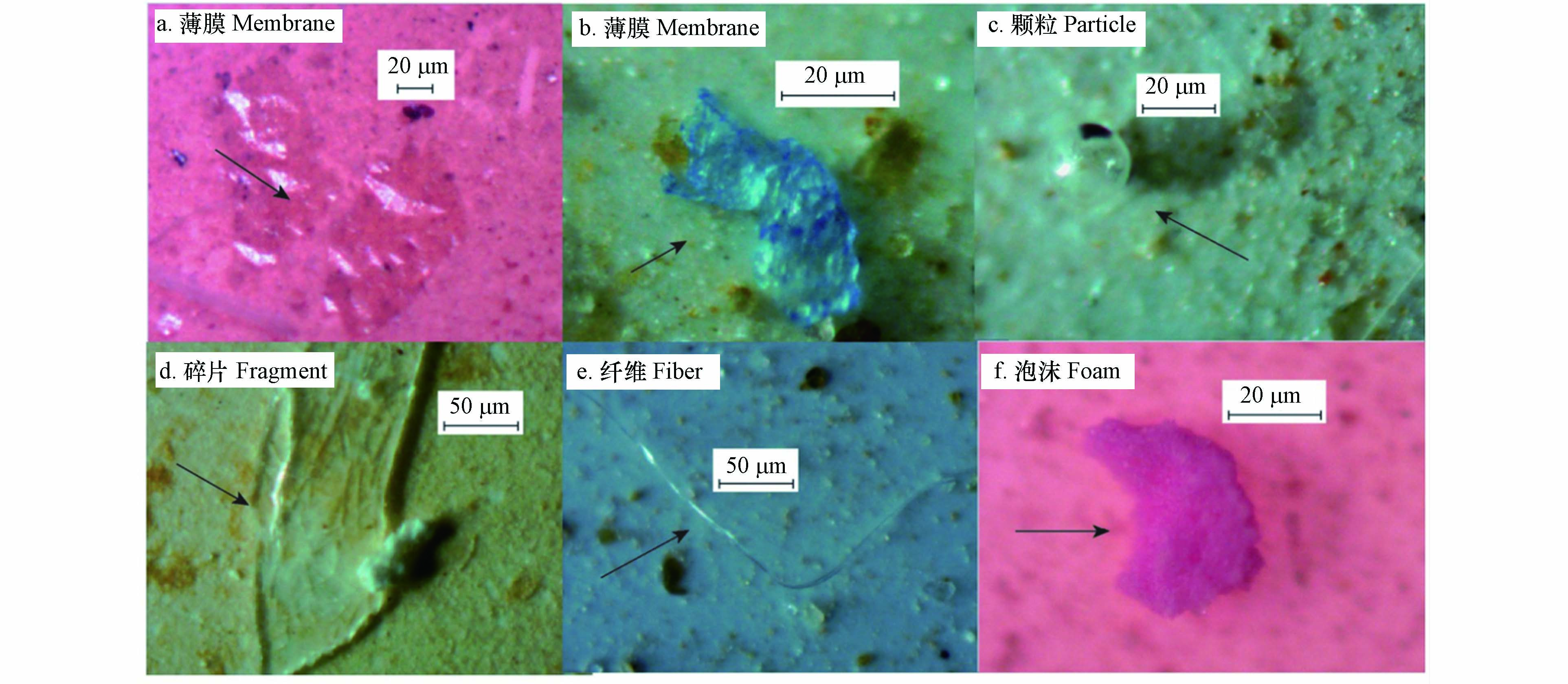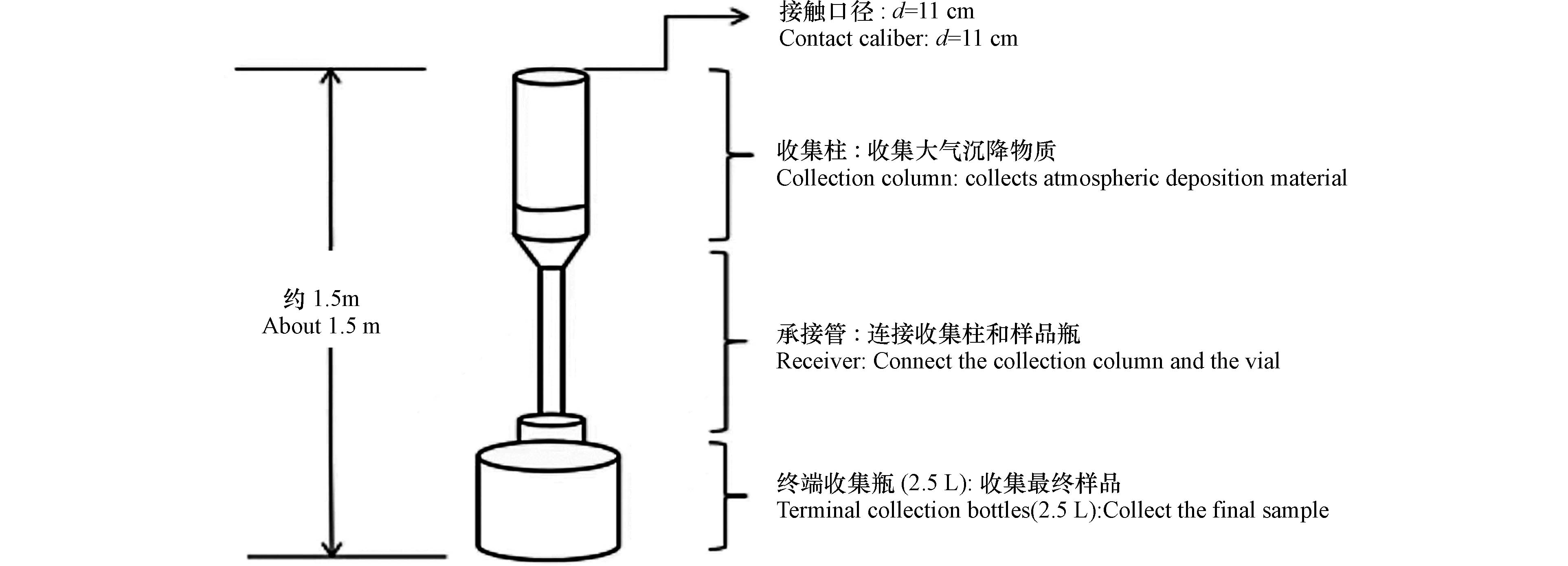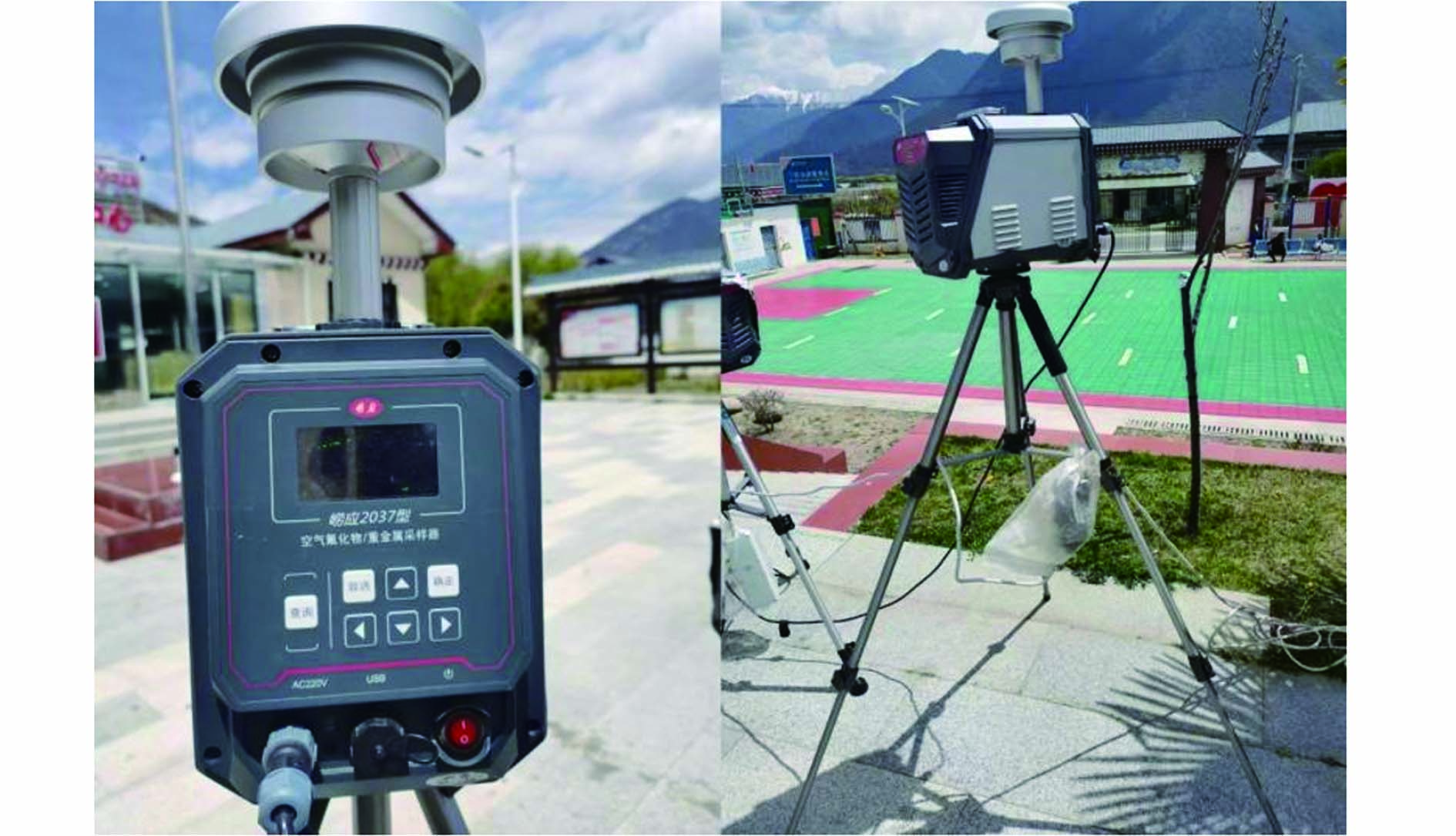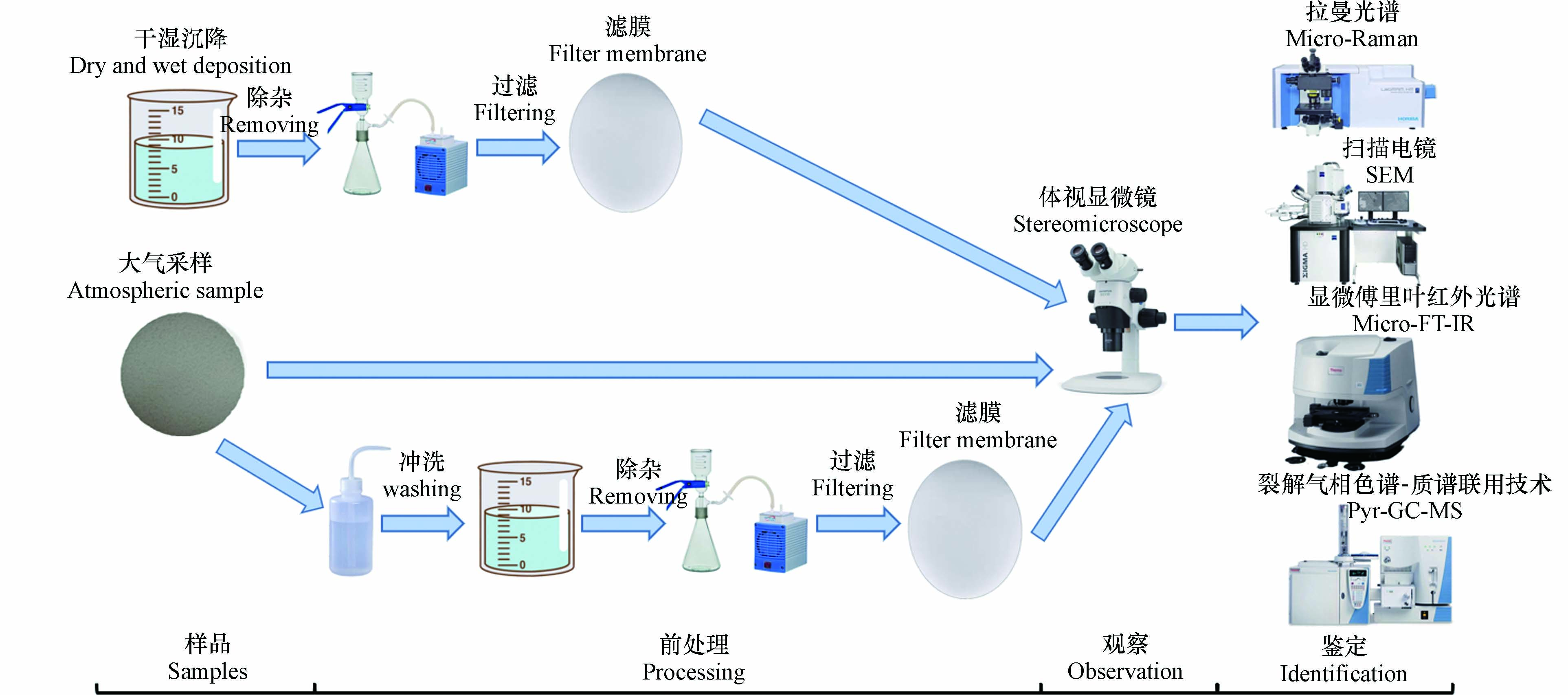-
20世纪中叶以来,塑料因其质轻、价廉、耐用、防水和耐腐蚀等优质性能,被普遍应用于医疗、工农业、航空、建筑及日常生活中. 据调查,2018年全球产生塑料约3.59亿t[1],累计83亿t[2],预计到2050年塑料年产量将达到11.24亿t,累计330亿t[3]. 而我国是塑料的生产大国,据统计,2021年我国塑料产量累计为8004万t[4]. 塑料制品的生产和使用给人类生活带来极大的便利,但也给环境造成了很大的污染. 进入环境的塑料在一些外力作用下,会成为粒径更小的微塑料.
“微塑料”这一术语是英国学者Thompson于2004年首次提出的,并在海洋沉积物中发现了这种物质[5]. 目前,微塑料是指粒径<5 mm的塑料碎片和颗粒[6]. 根据其来源可分为工业直接制造的原生微塑料(如化妆品、洗护用品)和由大型塑料降解、破裂形成的次生微塑料[7]. 微塑料具有较小的体积和密度,化学性质稳定,可在环境中长久存在,在风、河流、洋流等作用下能够进行长距离的迁移,甚至可以到偏远地区以及极地冰川;同时,微塑料易吸附持久性有机物、重金属和抗生素等,被生物摄取后在食物链中累积,危害生态环境和人体健康,所以学者开始广泛关注微塑料的研究.
目前,对微塑料的研究主要集中在水体[8-13]、沉积物[14-18]和生物体[19-20]中,而对大气中微塑料的研究还很少. 2015年,Dris等[21]首次在巴黎市区的大气沉降物中发现了微塑料. 此后,研究者相继报道了伊朗德黑兰[22]、土耳其萨卡里亚[23]、英国伦敦[24]、日本草津[25]和美国加利福尼亚[26]等地微塑料的分布特征. 近年来,国内也相继研究了东莞[27]、烟台[28-29]、上海[30]、北京[31]、大连[32]、哈尔滨[33]和宜昌[34]等地的大气微塑料.
大气微塑料污染的研究主要集中在几个地区,对偏远地区的研究较少. 然而,在偏远地区开展大气微塑料的研究,识别大气微塑料的来源和迁移转化机制也是十分有必要的,如青藏高原虽然排放的大气污染物较少,污染物浓度相对较低,但对周边影响及变化极为敏感,且保护着我国的生态安全,是天然的生态保护屏障,其重要性不言而喻. 从大气微塑料特征、研究方法、毒理效应的研究进展等方面展开阐述,提出未来的研究方向,为保护生态环境安全提供依据.
-
大气微塑料粒径分布范围较广,但主要分布在<0.5 mm的区间(表1). 伊朗阿萨鲁耶[38]的研究发现大气微塑料尺寸总体呈正偏态分布,100 μm以下的颗粒占比在75%以上. Zhu等[42]研究了中国5所城市的大气微塑料,结果表明<30 μm和30—100 μm的微塑料分别为61.6%和33.1%. Allen等[43]对法国比利牛斯山脉研究发现大气中<25 μm和25—50 μm的碎片微塑料分别占53%和32%. 这可能是因为尺寸小的微塑料质量较轻,更容易悬浮在空气中,而颗粒较大的微塑料会快速沉降.
-
大气微塑料颜色多元,常见黑色(灰色)、白色(透明)、蓝色(绿色)、红色(粉色)、棕色、橙色、紫色和黄色等,其中最多的为黑色(灰色)和白色(透明)(表1). Liu等[41]在中国上海某校园内大气中发现56%的微塑料为黑色、白色和透明. Wang等[35]发现,在南海和东印度洋大气微塑料中黑色最多,占37.5%—60%. Abbasi等[38]在伊朗阿萨鲁耶大气中发现,白色(透明)的微塑料最为常见,占比66%. 但有色塑料可能会被H2O2漂白[16]或被紫外线照射褪色,从而导致白色微塑料被高估.
-
微塑料形状主要为纤维、碎片、薄膜、颗粒、泡沫和微珠(图1). 在大部分地区,纤维占主导地位. Cai等[27]研究中国东莞大气微塑料时,发现纤维是主要形状,中国烟台[28]、英国伦敦[36]和法国巴黎[24]等的研究中结论一样,纤维分别占比95%、92%和100%. 但也有一些研究发现,碎片占据主导地位. Klein等[39]发现,德国汉堡大气微塑料中95%为碎片,法国比利牛斯山脉的大气微塑料研究中也得出一样的结论[43]. 总的来看,微塑料的形状以纤维和碎片为主. 纤维的质量较轻,更容易悬浮在空气中,这可能导致其丰度较高.
-
大气微塑料有天然聚合物和合成聚合物. 天然聚合物包括纤维素和蛋白质,合成聚合物主要有20多种类型,如聚对苯二甲酸乙二醇酯(PET)、聚乙烯(PE)、聚苯乙烯(PS)、聚丙烯(PP)等. 其中,PET占据主要地位. 根据Liu等[41]和Wang等[35]的研究,PET的占比分别为51%和50%. 微塑料的组分与其形状存在一定的关系,纤维状微塑料中PET含量高达87%[30],所以PET在大气微塑料聚合物中占比较高.
-
根据采样和分析方法的不同使用不同的单位表征大气微塑料的丰度(表1). 被动采样收集的大气沉降物以大气微塑料的沉降通量个·(m2·d)−1来表征,如法国巴黎[36]、德国汉堡[39]、中国东莞[27]和中国烟台[28]大气微塑料沉积通量的范围在2—925 个·(m2 ·d)−1;主动采样法采集的悬浮颗粒物则用大气微塑料的浓度来表征,即个·m−3(或个·m−2),研究表明,法国巴黎[37]、中国上海[30]、日本草津[25]大气微塑料的丰度范围为0—59.4 个·m−3或0—33.4个·m−2.
-
大气中的微塑料主要来自合成纺织品、合成橡胶轮胎的磨损和城市灰尘,占比分别为34.8%、28.3%和24.2%[45].
用于纺织行业的塑料纤维,在洗涤、晾晒和干燥时会释放至环境中. 有研究表明,用洗衣机洗衣时,单件衣服大约会产生1900 个塑料纤维[46]. 刘艳等[47]的研究结果也显示,每3 克织物洗涤时会释放1300—1500 个塑料. Brien等[48]认为烘干机干燥衣服会导致塑料纤维排放且排放量约占被烘干衣物质量的1.2
‱ . 此外,新冠疫情爆发以来,一次性防护口罩使用量大幅度增加. 陈贤川等[49]研究了一次性防护口罩微塑料释放情况,发现没有用过的口罩平均释放71.7—308.3 个·只−1,使用过的口罩平均释放682.7—1918个·只−1. 轮胎磨损产生的颗粒能在大气中持久存在,研究表明全球年均释放量在500万吨左右[50]. 城市灰尘同样是大气微塑料的潜在重要来源,Dehghani等[22]在10 条街道扬尘中发现,每30 g干尘中含有88—605 种微塑料.大气微塑料的其他来源还包括塑料垃圾堆放、填埋或焚烧[51]、工农业生产[52]、建筑材料[53]等. 此外,海洋微塑料也能成为大气微塑料的源(图2). Trainic等[54]对北大西洋洋面大气微塑料分析,发现与海水相比,PE和PP密度更小,可在海面上富集,易进入洋面大气.
-
大气微塑料的采集方法有被动采样和主动采样两种. 被动采样法是利用分子扩散原理进行长时间收集,使大气微塑料沉降到容器内的一种采样方法,其装置如图3所示,由收集柱、承接管和终端收集瓶3部分组成[55]. 2015年,Dris等[21]使用被动采样法,首次对巴黎城区和郊区大气沉降物进行了分析,发现含有微塑料颗粒. 周倩等[28]于2017年通过被动采样法在中国滨海城市采集了大气微塑料沉降样品,并对其种类、沉降通量和季节性变化特征进行了分析. 被动采样法虽然简单方便,可分析大气微塑料的类型、沉降通量及迁移动力学等,但不能获取微小的微塑料颗粒物,且难以确定大气采样的相对数量和收集的微塑料是否仅来源于大气沉积[56],所以,越来越多的学者青睐于主动采样法.
主动采样法是利用泵式采样器将大气中的样品收集至滤膜上(图4). Liu等[30]通过KB-120F型智能中间流全悬浮颗粒物采样器采集大气样品,探讨了样品丰度与过滤空气采样体积的关系. 门志远等[33]使用MiniVol便携式大气颗粒物采样器采集哈尔滨大气样品,得到悬浮大气微塑料的丰度分布、类型、粒径、颜色和化学组成等数据信息. 与被动采样法相比,主动采样法大大缩短了采样时间,但受天气影响较大,雨天不宜采集.
-
微塑料粒径小,不易观测,采集的样品组成复杂,会与环境介质产生一定的混合,所以在分析研究之前,必须进行适当的预处理,将微塑料从复杂的环境样品中分离提取出来以达到后续鉴定的要求. 大气微塑料样品的预处理方法主要有浓缩、消解和分离[57],具体流程和方法如图5所示,其中浓缩处理应用较为广泛.
-
大气微塑料丰度较低,所以需要对样品进行浓缩处理. 样品的浓缩方法包括筛分和过滤.
筛分法是利用筛子的孔径对不同粒径的颗粒进行分离的过程,筛网材质一般为不锈钢. 首先用5 mm的筛网将样品中粒径较大的颗粒和杂质剔除,然后利用一系列不同孔径的筛网进行粒径分级,再用滤膜或筛网过滤,最后将筛网上的颗粒冲洗下来,保存于玻璃瓶中[59]. 用筛分法进行粒径分级时,通常需要2—4个筛网,孔径范围为0.038—5 mm[60].
过滤法与筛分法类似,均是用细小的孔截留微塑料,得到的微塑料尺寸都与所使用的筛网或滤膜孔径有关,不同的是过滤法使用的截留材料为滤膜,通常由玻璃纤维、石英纤维、氧化铝膜和聚四氟乙烯等制成. 滤膜的孔径较小,大约在0.45—2 μm[61—63],因此容易堵塞,所以过滤法一般采用降压抽滤的方式,但这会使微塑料难以洗脱. 有研究表明,50%的异丙醇溶液可以较好地解决这一问题[64].
筛分法和过滤法操作简单,不用复杂的处理即可实现微塑料尺寸的分级,但提纯效果较差,且筛分法受筛网孔径限制,很难得到较小粒径,过滤法则容易造成微塑料丢失.
-
样品中携带有机质会干扰微塑料的定量和定性分析,为了去除有机质,提高分析结果的准确性,需要对样品进行消解. 目前采取的消解方法主要有酸消解、碱消解、氧化剂消解和酶消解[65].
酸消解过程中常用的酸溶液有HCl、HNO3及混合酸. HCl氧化性较弱,不能破坏所有的有机质,消解率相对较低(<90%),使用时浓度通常要高于20%;HNO3消解率高,被广泛用于酸性消解,但由于其强腐蚀性,消解过程会造成聚合物的损失或变色,油性残留物也会影响微塑料的回收率[66]. HNO3和HClO4混合消解可以提高微塑料的回收率. De Witte等[67]用体积比为4∶1的65%HNO3和68%HClO4混合溶液在室温下消解贻贝组织,发现能有效去除油性残留物,减轻单一HNO3消解的损失率. 总之,酸消解具有消解彻底、快速、廉价和易操作等优点,但消解温度不宜过高(60 ℃为宜),对一些样品消解效果不佳.
碱消解是利用碱溶液破坏蛋白质、碳水化合物和脂肪的结构,从而进行消解的一种方法,常用的碱溶液有KOH和NaOH[68]. 碱消解效果较好,聚合物受碱消解的影响较小,但聚对苯二甲酸乙二醇酯、聚酰胺、醋酯纤维易受碱消化剂的影响.
大气微塑料样品使用较多的是氧化剂消解,一般使用30%的H2O2溶液,其价格便宜,成分简单,可有效消解有机质,且对微塑料颗粒影响较小,除了PE和PP的尺寸略有变化[69],对聚合物几乎没有降解作用. 王志超等[70]对比了7种微塑料的消解方法,其中室温下30%的H2O2消解使微塑料减少2%—5%,对表面形态和内部结构有轻微破坏,不会对后续的分析产生影响,而其他消解方法则会破坏微塑料,得出30%的H2O2对微塑料破坏最小的结论. 温度对H2O2消解有较大影响,高温下消解速率较快. Cole等[71]在室温下用35%的H2O2消解7 d,仅消解25%的有机质,而Avio等[72]用15%的H2O2在50 ℃的条件下消解一夜,即可有效去除有机质. 此外,H2O2消解可能会漂白有色微塑料,所以有研究使用Fenton试剂(40 ℃以下,pH值接近3)进行消解,能有效去除有机物,又不会破坏微塑料,具有高效、成本低、消解速度快的优点[73].
酶消解是利用酶来去除有机质,适用于生物质含量较高的样品,常用的酶包括纤维素酶、蛋白酶、脂肪酶等[74]. 酶消解的危害较小,一般不会对微塑料造成损害. Cole等[72]比较了酸消解、碱消解及酶消解的效果,发现酸消解会消解部分微塑料;碱消解消解率较高,但浓度高时也会破坏部分微塑料;而蛋白酶对有机质去除率达到97%以上的同时不会分解微塑料. 然而,酶消解价格昂贵,只适合少量样品的消解,所需时间也较长,且每种酶都需要最佳温度和pH值.
-
目前常使用密度分离法,即利用微塑料与杂质的密度差异实现两者的分离. 其操作步骤是:首先向样品中加入高密度的饱和盐水(一般为NaCl、NaI或ZnCl2),充分振荡、搅拌混合均匀,然后静置至重组分杂质重新沉降而轻组分微塑料漂浮于溶液表面,最后收集上层溶液中的微塑料[75]. 因NaCl溶液(密度为1.2 g·cm−3)价廉易得、无毒有效,常选其作为密度分离法的浮选剂,尤其是分离密度较小的微塑料,如聚丙烯和聚乙烯. 但NaCl溶液不能完全分离沉积物中的聚合物,在分离高密度微塑料(如聚氯乙烯等)时会使结果偏小[76]. 与NaCl溶液相比,NaI和ZnCl2溶液密度更大,分别为1.6—1.8 g·cm−3和1.5—1.7 g·cm−3,能分离密度较大的微塑料样品. Abbasi等[77]采用NaI溶液成功分离了街道扬尘中的微塑料. 但NaI价格昂贵,ZnCl2对环境有危害,都只在少数实验中使用. 大气微塑料预处理方法优缺点具体见表2.
-
大气微塑料检测分析包括定性分析和定量分析,定性分析通常又可分为物理形态分析和化学组分分析. 物理形态分析主要针对微塑料的尺寸、颜色、形态等表观性状,化学组分分析是分析微塑料的聚合物类型. 常用的分析技术有目视法、体视显微镜、扫描电子显微镜(SEM)等物理表征手段和傅里叶变换红外光谱法(FTIR)、拉曼光谱(RM)、裂解气相色谱-质谱联用技术(Pyro-GC-MS)等化学表征手段,相关分析技术比较见表3,其中浓缩处理、体视显微镜和FTIR应用较为广泛(表4).
-
目视法可以对2—5 mm的彩色塑料碎片和树脂颗粒进行分析,但小块(<1 mm)且无色、无特定形状的样品很难用目视法直接观察出来.
-
体视显微镜操作简单、经济,可以直接观测到微塑料的尺寸、形状和颜色等物理性质,但体视显微镜在鉴定小粒径的微塑料时容易错判、误判,鉴定尺寸最小为50 μm. 研究表明,显微镜鉴定微塑料的出错率达20%,其中透明颗粒的误判率超过70%[78].
-
SEM直接通过样品表面材料的物质组成得到高分辨率的微塑料表面纹理图像,可精确检测不同尺寸和形态的微塑料颗粒[58],但该方法只能得到物质的表面形态. 与能谱仪联用时能得到微塑料的元素组成,从而将以碳元素为主体的微塑料与无机颗粒进行区分,但该技术存在费用高、通量低等不足.
-
FTIR是检测大气微塑料样品时运用最多的技术,广泛用于分子结构和化学组分研究. 该技术能够检测尺寸较小的微塑料颗粒,需要的样本量小,且不损害样品、准确性高,可以通过塑料颗粒的特征光谱获得具体的聚合物信息进而确定聚合物类型[79],除此之外还可以获得微塑料的数量信息.
傅里叶变换红外光谱仪与显微镜结合的μ-FTIR光谱法有透射、反射和衰减全反射等3种模式. 透射模式能产生高质量光谱,适合检测透光性好的样品,但需要红外滤光片. Wang等[35]就使用了透射模式对中国南海和东印度洋的微塑料样品进行分析. 反射模式是检测微塑料的一种理想方式,不仅不会破坏样品、对样品需求最小,而且对厚而不透明的材料可以产生红外吸收光谱,但该模式适合背景较亮、反射光较强的样品,对样品表面的平整程度要求也较高. Cai等[27]对东莞大气微塑料的研究中使用了反射模式. 衰减全反射模式比反射模式的折射误差小,检测准确度更高,但不适合丝状微塑料的检测.
-
与FTIR一样,RM也是一种非破坏性检测微塑料的方法,其不仅能得到微塑料表面官能团信息,还能观察到局部微观形貌. 拉曼光谱是一种基于光的非弹性散射的振动光谱技术. 当把激光束打在待测样品上时,由于分子结构不同,产生散射光的频率也不同,从而会得到独特的光谱,然后通过与参比谱库对比,实现对聚合物成分的鉴别[80].
与FTIR相比,RM分辨率更高,能识别低至1 μm的微塑料[81]. 但RM对微塑料中的添加剂和化学染料极为敏感,易受荧光干扰. 目前,研究中常用荧光染料(如尼罗红)进行染色来辅助拉曼光谱检测[43].
-
Pyro-GC-MS是一种具有破坏性的微塑料分析方法,通过气相色谱-质谱分析大分子的热解产物来获取其结构信息[58]. 其原理是首先在严格的实验条件下将样品加热,在加热过程中逐渐热解析或热裂解成可挥发的小分子化合物,这些小分子通过气相色谱分离后,由质谱进行分析鉴定,最后与已有数据库进行对比,从而推断聚合物类型[82]. Pyro -GC-MS检出灵敏度高,能够对复杂基底环境中的样品进行批量分析,样品用量少、不需要预处理,可以对粒径非常小的样品进行检测,并且可以同时鉴定聚合物类型和添加剂,但对实验条件要求较高,无法分析微塑料颜色、形状、尺寸和数量等信息.
-
大气微塑料经大气扩散进入其他生态系统后,会对生态系统的结构和功能产生影响. Sridharan等[84]发现,大气微塑料沉降到树叶上会影响植物的光合作用,进而对森林冠层生态系统的碳氮循环和群落结构产生影响. 另外,大气微塑料会随风沉降至南北极和青藏高原等生态脆弱区,从而对该地区的生态系统造成潜在影响.
大气微塑料能吸收或散射光线,降低大气能见度,而大气能见度是衡量大气环境质量的重要指标. 与其他颗粒物一样,大气微塑料也可以成为云、冰的冷凝核素,影响云的光学和化学性质,改变大气湿度和降水量条件[85]. 研究表明大气微塑料能通过反射阳光辐射对气候产生微小的冷却效果,但持续的累积可能在未来展现更强的气候效应[86].
-
大气微塑料对人体健康存在潜在威胁,人体可通过呼吸吸入、食物摄入和皮肤接触等途径暴露在大气环境中,其中呼吸吸入是最主要的方式. 尺寸较大的颗粒会被打喷嚏、擤鼻涕等机械作用和黏膜纤毛运输等生理作用排出,而尺寸较小的颗粒则会沉积在人体内,对人体产生危害[87].
大气微塑料进入人体后,首先会对呼吸系统造成损坏,轻者会导致内分泌紊乱、呼吸困难等,严重的会诱发急、慢性疾病,造成肺部的炎症和DNA损伤,免疫力下降,甚至可导致遗传性病变和癌变等[88]. 极微小的微塑料甚至可以进入血液和淋巴循环,与其他污染物结合,导致动脉硬化阻塞,引起冠状动脉疾病[53]. Prata等[89]研究表明,25 nm的PS很容易被肺部细胞吸收,造成细胞因氧化应激而死亡、代谢紊乱等,最终导致炎症甚至其他恶性疾病.
一些研究者通过细胞的体外培养,讨论了微塑料的细胞毒性机制[90-92],但没有在实际环境中对其暴露风险进行研究,缺少吸入微塑料对生物体内循环过程影响的研究,导致微塑料的毒性参数和人体暴露参数值缺失,大气微塑料引起的健康风险及影响机制无法确定,需要更多的实验数据做支撑.
-
大气微塑料在全球广泛分布,对其的研究正在快速展开,近年来已成为研究热点. 但是由于起步较晚,尚在起步阶段,没有形成完整的理论体系,需要进行更多的研究. 本文对大气微塑料形态种类、采样和预处理方法、分析鉴定技术及其生态毒理效应等进行了综述,主要结论与展望如下:
(1)目前大气微塑料的采集方法为主动采样法和被动采样法,由于没有统一的采样方法,微塑料丰度的表征方式也无法统一,各地的污染程度无法直接比较. 针对这一问题,要统一采样方法和操作规范,制定统一的丰度单位,实现数据的规范性和可比性.
(2)大气微塑料种类繁多,来源复杂,可远距离迁移至偏远地区,对生态环境造成影响,因此有必要研究大气微塑料的来源、迁移规律和传输途径,为制定源头控制、过程减排和终端治理的措施提供科学依据. 此外,仍缺乏大气微塑料的长期监测数据和偏远地区的研究数据(如青藏高原和极地),因此要在更大范围开展长期观测研究,加强大气微塑料的时空分布规律研究.
(3)大气微塑料样品浓缩处理主要有筛网筛分和滤膜过滤;消解处理主要采用H2O2去除有机质;分离主要采用NaCl、NaI或ZnCl2溶液密度分离. 不同类型的微塑料在不同处理方式下回收率也不同,这会导致相同样品获得不同的结果,为保证大气微塑料分析的准确性,应统一规范样品预处理的试剂、装置及相关参数.
(4)主要利用体视显微镜和扫描电子显微镜对大气微塑料进行物理分析;化学成分分析多使用傅里叶变换红外光谱仪,拉曼光谱和裂解气相色谱-质谱联用技术应用较少. 这些分析方法存在不同程度的缺陷,如耗时耗力,成本较高,只能反映少量的参数信息等,因此,要建立标准化的检测分析技术并开发精准、高效和低成本的分析方法.
(5)大气微塑料可跨多介质传输到不同生态系统中,并通过多种途径进入人体,对生态系统和人体健康具有潜在风险. 目前大气微塑料对人体产生的健康风险研究仍缺乏系统性,且主要基于体外实验和动物模型,研究成果匮乏,评价机制尚不明确,未来需要建立生物模型,采取多种研究手段,更全面地评估大气微塑料对人体的健康效应.
大气中微塑料的研究进展
Research progress on microplastics in the atmosphere
-
摘要: 微塑料(microplastics,Mps)是一种可以在环境和有机体中积聚的新污染物,其粒径较小、稳定性较好、生物降解较难,会对生态环境和人类健康造成危害,因此引起了国内外的高度关注. 近些年,微塑料相继在不同介质中被检出,且数量持续增多,甚至在人口稀少的青藏高原也被检出. 文章梳理了大气微塑料的赋存特征、来源途径和毒理效应,介绍了目前大气中微塑料的采集方法和检测分析技术,最后在目前研究的基础上,对未来大气微塑料的研究做出展望.Abstract: Microplastics (MPS) are a new type of pollutant, which can accumulate continuously in the environment and organisms, and has the characteristics of small particle size, good stability and difficult biodegradation, which endangers the ecological environment and human health, Therefore they have attracted great attention at home and abroad. In recent years, microplastics have been detected in different media, and the number continues to increase, even in the sparsely populated Qinghai-Tibet Plateau. This paper sorts out the characteristics, source and toxicological effects of microplastics in the atmospheric environment, introduces the current collection methods and detection and analysis technologies of microplastics in the atmosphere, and finally makes an outlook for the future research of atmospheric microplastics on the basis of the current research.
-
Key words:
- atmospheric microplastics /
- features /
- analytical methods /
- ecological effects
-
20世纪中叶以来,塑料因其质轻、价廉、耐用、防水和耐腐蚀等优质性能,被普遍应用于医疗、工农业、航空、建筑及日常生活中. 据调查,2018年全球产生塑料约3.59亿t[1],累计83亿t[2],预计到2050年塑料年产量将达到11.24亿t,累计330亿t[3]. 而我国是塑料的生产大国,据统计,2021年我国塑料产量累计为8004万t[4]. 塑料制品的生产和使用给人类生活带来极大的便利,但也给环境造成了很大的污染. 进入环境的塑料在一些外力作用下,会成为粒径更小的微塑料.
“微塑料”这一术语是英国学者Thompson于2004年首次提出的,并在海洋沉积物中发现了这种物质[5]. 目前,微塑料是指粒径<5 mm的塑料碎片和颗粒[6]. 根据其来源可分为工业直接制造的原生微塑料(如化妆品、洗护用品)和由大型塑料降解、破裂形成的次生微塑料[7]. 微塑料具有较小的体积和密度,化学性质稳定,可在环境中长久存在,在风、河流、洋流等作用下能够进行长距离的迁移,甚至可以到偏远地区以及极地冰川;同时,微塑料易吸附持久性有机物、重金属和抗生素等,被生物摄取后在食物链中累积,危害生态环境和人体健康,所以学者开始广泛关注微塑料的研究.
目前,对微塑料的研究主要集中在水体[8-13]、沉积物[14-18]和生物体[19-20]中,而对大气中微塑料的研究还很少. 2015年,Dris等[21]首次在巴黎市区的大气沉降物中发现了微塑料. 此后,研究者相继报道了伊朗德黑兰[22]、土耳其萨卡里亚[23]、英国伦敦[24]、日本草津[25]和美国加利福尼亚[26]等地微塑料的分布特征. 近年来,国内也相继研究了东莞[27]、烟台[28-29]、上海[30]、北京[31]、大连[32]、哈尔滨[33]和宜昌[34]等地的大气微塑料.
大气微塑料污染的研究主要集中在几个地区,对偏远地区的研究较少. 然而,在偏远地区开展大气微塑料的研究,识别大气微塑料的来源和迁移转化机制也是十分有必要的,如青藏高原虽然排放的大气污染物较少,污染物浓度相对较低,但对周边影响及变化极为敏感,且保护着我国的生态安全,是天然的生态保护屏障,其重要性不言而喻. 从大气微塑料特征、研究方法、毒理效应的研究进展等方面展开阐述,提出未来的研究方向,为保护生态环境安全提供依据.
1. 大气微塑料的赋存特征和来源(Characteristics and sources of atmospheric microplastics)
1.1 大气微塑料的赋存特征
1.1.1 尺寸
大气微塑料粒径分布范围较广,但主要分布在<0.5 mm的区间(表1). 伊朗阿萨鲁耶[38]的研究发现大气微塑料尺寸总体呈正偏态分布,100 μm以下的颗粒占比在75%以上. Zhu等[42]研究了中国5所城市的大气微塑料,结果表明<30 μm和30—100 μm的微塑料分别为61.6%和33.1%. Allen等[43]对法国比利牛斯山脉研究发现大气中<25 μm和25—50 μm的碎片微塑料分别占53%和32%. 这可能是因为尺寸小的微塑料质量较轻,更容易悬浮在空气中,而颗粒较大的微塑料会快速沉降.
表 1 大气微塑料的赋存特征Table 1. Occurrence characteristics of atmospheric microplastics采样地点Sampling location 尺寸Size 颜色Color 形状Shape 组分Component 丰度Abundance 文献Literature 中国烟台 <0.5 mm(72%)0.5—1 mm(16%)1—2 mm(9%)2—3 mm(3%)>3 mm(<1%) 黑、白、红、透明 纤维(95.05%)碎片(4.04%)薄膜(0.73%)发泡(0.18%) PET、PV(聚氯乙烯树脂)、PE、PS 130—624个·(m2 ·d)−1 [28] 中国东莞 <200 μm(7%)200—700 μm(30%)700—1200 μm(20%)1200—1700 μm(17%)1700—2700 μm(17%)2700—5000 μm(9%) 纤维(90.1%)碎片(6.8%)薄膜(2.9%)泡沫(0.2%) PE、PP、PS、纤维素 23—47个·(m2 ·d)−1 [27] 中国上海 23—9555 μm 黑、红、黄、灰、棕、绿、透明 纤维(72.09%)碎片(26.74%)颗粒(1.16%) PET、PES(聚醚砜)、PE、PAN(聚丙烯腈) 0—4.18个·m−2 [30] 中国南海 340—1840 μm 黑、红、黄 纤维(73.9%)碎片(26.1%) PP、PET、PEVA(聚乙烯-醋酸乙烯酯) 0—0.31×10−2个·m−3 [35] 中国珠江 348—1456 μm 黑、白、红、黄、棕 纤维 PET、PP、PA(聚酰胺) 3—7.7×10−2个·m−3 [35] 法国巴黎 100—500 μm(22%)500—1000 μm(29%)1000—5000 μm(49%) 纤维(90%)碎片(10%) 29—280个·(m2 ·d)−1 [21] 法国巴黎 <200 μm(4.8%)200—400 μm(18.7%)400—600 μm(22.1%)600—800 μm(14.1%)800—1000 μm(11.7%)1000—5000 μm(28.6%) 纤维 PET、PA、纤维素 2—355个·(m2 ·d)−1 [36] 法国巴黎 50—4850 μm 纤维 PA、PET、PE、PP、纤维素 0.3—59.4个·m−3 [37] 伊朗德黑兰 <100 μm(6%)100—250 μm(15%)250—500 μm(34%)500—1000 μm(20%)1000—5000 μm(26%) 黑(灰)、黄(橙)、蓝、红(粉)、绿、棕、透明(白) 纤维(33.8%)颗粒(65.6%)微珠(0.6%) 2.4—20.5个·g−1 [22] 伊朗阿萨鲁耶 25—5000 μm 白(透明)、橙(黄)、红(粉)、蓝(绿)、黑(灰) 纤维、碎片、微球、薄膜 PA、尼龙 2.7—66.7个·g−1 [38] 德国汉堡 <63 μm(73.2%)63—300 μm(22.7%)>300 μm(4.1%) 碎片(95%)纤维(5%) PE、PET、PVA(聚乙烯醇)、EVAC(乙烯-乙酸乙烯酯共聚物) 136.5—512个·(m2 ·d)−1 [39] 日本草津 453—2347 μm 黑、灰、白(透明)、黄、棕、红、蓝、绿 碎片、薄膜、纤维、颗粒 PET、PS、PP、PE、PAK、PVS、EPC 0.4—3.6个·m−2 [25] 越南舰岗 261—1321 μm 黑、灰、白(透明)、黄、绿、红、棕 纤维(14.8%)碎片(60.6%)薄膜(12.3%)颗粒(12.3%) PET、PS、PP、PE、PAK(聚酯醇酸树脂)、SBR(丁苯橡胶)、PU(聚氨酯) 6—33.4个·m−2 [25] 英国伦敦 20—2800 μm 纤维(92%) PAN、PET、PVC(聚氯乙烯)、PP、PA、PE、PS 12—925个·(m2 ·d)−1 [24] 西太平洋 16—2086 μm 纤维、碎片、颗粒 PET、PS、PE、EP(环氧树脂)、PES、PVC、PP、PAN 0—1.37个·m−3 [40] 东印度洋 59—988 μm 黑、蓝、黄 纤维(79.2%)碎片(20.8%) PP、PET 0—0.8×10−2个·m−3 [41] 1.1.2 颜色
大气微塑料颜色多元,常见黑色(灰色)、白色(透明)、蓝色(绿色)、红色(粉色)、棕色、橙色、紫色和黄色等,其中最多的为黑色(灰色)和白色(透明)(表1). Liu等[41]在中国上海某校园内大气中发现56%的微塑料为黑色、白色和透明. Wang等[35]发现,在南海和东印度洋大气微塑料中黑色最多,占37.5%—60%. Abbasi等[38]在伊朗阿萨鲁耶大气中发现,白色(透明)的微塑料最为常见,占比66%. 但有色塑料可能会被H2O2漂白[16]或被紫外线照射褪色,从而导致白色微塑料被高估.
1.1.3 形状
微塑料形状主要为纤维、碎片、薄膜、颗粒、泡沫和微珠(图1). 在大部分地区,纤维占主导地位. Cai等[27]研究中国东莞大气微塑料时,发现纤维是主要形状,中国烟台[28]、英国伦敦[36]和法国巴黎[24]等的研究中结论一样,纤维分别占比95%、92%和100%. 但也有一些研究发现,碎片占据主导地位. Klein等[39]发现,德国汉堡大气微塑料中95%为碎片,法国比利牛斯山脉的大气微塑料研究中也得出一样的结论[43]. 总的来看,微塑料的形状以纤维和碎片为主. 纤维的质量较轻,更容易悬浮在空气中,这可能导致其丰度较高.
1.1.4 组分
大气微塑料有天然聚合物和合成聚合物. 天然聚合物包括纤维素和蛋白质,合成聚合物主要有20多种类型,如聚对苯二甲酸乙二醇酯(PET)、聚乙烯(PE)、聚苯乙烯(PS)、聚丙烯(PP)等. 其中,PET占据主要地位. 根据Liu等[41]和Wang等[35]的研究,PET的占比分别为51%和50%. 微塑料的组分与其形状存在一定的关系,纤维状微塑料中PET含量高达87%[30],所以PET在大气微塑料聚合物中占比较高.
1.1.5 丰度
根据采样和分析方法的不同使用不同的单位表征大气微塑料的丰度(表1). 被动采样收集的大气沉降物以大气微塑料的沉降通量个·(m2·d)−1来表征,如法国巴黎[36]、德国汉堡[39]、中国东莞[27]和中国烟台[28]大气微塑料沉积通量的范围在2—925 个·(m2 ·d)−1;主动采样法采集的悬浮颗粒物则用大气微塑料的浓度来表征,即个·m−3(或个·m−2),研究表明,法国巴黎[37]、中国上海[30]、日本草津[25]大气微塑料的丰度范围为0—59.4 个·m−3或0—33.4个·m−2.
1.2 大气微塑料的来源
大气中的微塑料主要来自合成纺织品、合成橡胶轮胎的磨损和城市灰尘,占比分别为34.8%、28.3%和24.2%[45].
用于纺织行业的塑料纤维,在洗涤、晾晒和干燥时会释放至环境中. 有研究表明,用洗衣机洗衣时,单件衣服大约会产生1900 个塑料纤维[46]. 刘艳等[47]的研究结果也显示,每3 克织物洗涤时会释放1300—1500 个塑料. Brien等[48]认为烘干机干燥衣服会导致塑料纤维排放且排放量约占被烘干衣物质量的1.2
‱ 大气微塑料的其他来源还包括塑料垃圾堆放、填埋或焚烧[51]、工农业生产[52]、建筑材料[53]等. 此外,海洋微塑料也能成为大气微塑料的源(图2). Trainic等[54]对北大西洋洋面大气微塑料分析,发现与海水相比,PE和PP密度更小,可在海面上富集,易进入洋面大气.
2. 大气微塑料采集、预处理及分析技术(Atmospheric microplastics collection, pretreatment and analysis technology)
2.1 大气微塑料的采集
大气微塑料的采集方法有被动采样和主动采样两种. 被动采样法是利用分子扩散原理进行长时间收集,使大气微塑料沉降到容器内的一种采样方法,其装置如图3所示,由收集柱、承接管和终端收集瓶3部分组成[55]. 2015年,Dris等[21]使用被动采样法,首次对巴黎城区和郊区大气沉降物进行了分析,发现含有微塑料颗粒. 周倩等[28]于2017年通过被动采样法在中国滨海城市采集了大气微塑料沉降样品,并对其种类、沉降通量和季节性变化特征进行了分析. 被动采样法虽然简单方便,可分析大气微塑料的类型、沉降通量及迁移动力学等,但不能获取微小的微塑料颗粒物,且难以确定大气采样的相对数量和收集的微塑料是否仅来源于大气沉积[56],所以,越来越多的学者青睐于主动采样法.
主动采样法是利用泵式采样器将大气中的样品收集至滤膜上(图4). Liu等[30]通过KB-120F型智能中间流全悬浮颗粒物采样器采集大气样品,探讨了样品丰度与过滤空气采样体积的关系. 门志远等[33]使用MiniVol便携式大气颗粒物采样器采集哈尔滨大气样品,得到悬浮大气微塑料的丰度分布、类型、粒径、颜色和化学组成等数据信息. 与被动采样法相比,主动采样法大大缩短了采样时间,但受天气影响较大,雨天不宜采集.
2.2 大气微塑料的预处理
微塑料粒径小,不易观测,采集的样品组成复杂,会与环境介质产生一定的混合,所以在分析研究之前,必须进行适当的预处理,将微塑料从复杂的环境样品中分离提取出来以达到后续鉴定的要求. 大气微塑料样品的预处理方法主要有浓缩、消解和分离[57],具体流程和方法如图5所示,其中浓缩处理应用较为广泛.
2.2.1 样品浓缩
大气微塑料丰度较低,所以需要对样品进行浓缩处理. 样品的浓缩方法包括筛分和过滤.
筛分法是利用筛子的孔径对不同粒径的颗粒进行分离的过程,筛网材质一般为不锈钢. 首先用5 mm的筛网将样品中粒径较大的颗粒和杂质剔除,然后利用一系列不同孔径的筛网进行粒径分级,再用滤膜或筛网过滤,最后将筛网上的颗粒冲洗下来,保存于玻璃瓶中[59]. 用筛分法进行粒径分级时,通常需要2—4个筛网,孔径范围为0.038—5 mm[60].
过滤法与筛分法类似,均是用细小的孔截留微塑料,得到的微塑料尺寸都与所使用的筛网或滤膜孔径有关,不同的是过滤法使用的截留材料为滤膜,通常由玻璃纤维、石英纤维、氧化铝膜和聚四氟乙烯等制成. 滤膜的孔径较小,大约在0.45—2 μm[61—63],因此容易堵塞,所以过滤法一般采用降压抽滤的方式,但这会使微塑料难以洗脱. 有研究表明,50%的异丙醇溶液可以较好地解决这一问题[64].
筛分法和过滤法操作简单,不用复杂的处理即可实现微塑料尺寸的分级,但提纯效果较差,且筛分法受筛网孔径限制,很难得到较小粒径,过滤法则容易造成微塑料丢失.
2.2.2 样品消解
样品中携带有机质会干扰微塑料的定量和定性分析,为了去除有机质,提高分析结果的准确性,需要对样品进行消解. 目前采取的消解方法主要有酸消解、碱消解、氧化剂消解和酶消解[65].
酸消解过程中常用的酸溶液有HCl、HNO3及混合酸. HCl氧化性较弱,不能破坏所有的有机质,消解率相对较低(<90%),使用时浓度通常要高于20%;HNO3消解率高,被广泛用于酸性消解,但由于其强腐蚀性,消解过程会造成聚合物的损失或变色,油性残留物也会影响微塑料的回收率[66]. HNO3和HClO4混合消解可以提高微塑料的回收率. De Witte等[67]用体积比为4∶1的65%HNO3和68%HClO4混合溶液在室温下消解贻贝组织,发现能有效去除油性残留物,减轻单一HNO3消解的损失率. 总之,酸消解具有消解彻底、快速、廉价和易操作等优点,但消解温度不宜过高(60 ℃为宜),对一些样品消解效果不佳.
碱消解是利用碱溶液破坏蛋白质、碳水化合物和脂肪的结构,从而进行消解的一种方法,常用的碱溶液有KOH和NaOH[68]. 碱消解效果较好,聚合物受碱消解的影响较小,但聚对苯二甲酸乙二醇酯、聚酰胺、醋酯纤维易受碱消化剂的影响.
大气微塑料样品使用较多的是氧化剂消解,一般使用30%的H2O2溶液,其价格便宜,成分简单,可有效消解有机质,且对微塑料颗粒影响较小,除了PE和PP的尺寸略有变化[69],对聚合物几乎没有降解作用. 王志超等[70]对比了7种微塑料的消解方法,其中室温下30%的H2O2消解使微塑料减少2%—5%,对表面形态和内部结构有轻微破坏,不会对后续的分析产生影响,而其他消解方法则会破坏微塑料,得出30%的H2O2对微塑料破坏最小的结论. 温度对H2O2消解有较大影响,高温下消解速率较快. Cole等[71]在室温下用35%的H2O2消解7 d,仅消解25%的有机质,而Avio等[72]用15%的H2O2在50 ℃的条件下消解一夜,即可有效去除有机质. 此外,H2O2消解可能会漂白有色微塑料,所以有研究使用Fenton试剂(40 ℃以下,pH值接近3)进行消解,能有效去除有机物,又不会破坏微塑料,具有高效、成本低、消解速度快的优点[73].
酶消解是利用酶来去除有机质,适用于生物质含量较高的样品,常用的酶包括纤维素酶、蛋白酶、脂肪酶等[74]. 酶消解的危害较小,一般不会对微塑料造成损害. Cole等[72]比较了酸消解、碱消解及酶消解的效果,发现酸消解会消解部分微塑料;碱消解消解率较高,但浓度高时也会破坏部分微塑料;而蛋白酶对有机质去除率达到97%以上的同时不会分解微塑料. 然而,酶消解价格昂贵,只适合少量样品的消解,所需时间也较长,且每种酶都需要最佳温度和pH值.
2.2.3 样品分离
目前常使用密度分离法,即利用微塑料与杂质的密度差异实现两者的分离. 其操作步骤是:首先向样品中加入高密度的饱和盐水(一般为NaCl、NaI或ZnCl2),充分振荡、搅拌混合均匀,然后静置至重组分杂质重新沉降而轻组分微塑料漂浮于溶液表面,最后收集上层溶液中的微塑料[75]. 因NaCl溶液(密度为1.2 g·cm−3)价廉易得、无毒有效,常选其作为密度分离法的浮选剂,尤其是分离密度较小的微塑料,如聚丙烯和聚乙烯. 但NaCl溶液不能完全分离沉积物中的聚合物,在分离高密度微塑料(如聚氯乙烯等)时会使结果偏小[76]. 与NaCl溶液相比,NaI和ZnCl2溶液密度更大,分别为1.6—1.8 g·cm−3和1.5—1.7 g·cm−3,能分离密度较大的微塑料样品. Abbasi等[77]采用NaI溶液成功分离了街道扬尘中的微塑料. 但NaI价格昂贵,ZnCl2对环境有危害,都只在少数实验中使用. 大气微塑料预处理方法优缺点具体见表2.
表 2 大气微塑料预处理方法汇总Table 2. Summary of pretreatment methods for atmospheric microplastics预处理方法Preprocessing method 优点Advantages 缺点Disadvantages 筛分过滤法 操作简单,可以快速实现微塑料尺寸的分级,不必对样品进行复杂处理 提纯度低,受筛网孔径限制,很难得到较小粒径 消解法 酸消解 快速、廉价、易操作 对一些样品消解效果不佳 碱消解 效果较好,聚合物受碱消解的影响较小 可能使塑料变色,沉积残留物对光谱信号产生干扰 氧化剂消解 价格便宜,成分简单,可有效消解有机质,且对微塑料颗粒影响较小 可能会漂白有色微塑料 酶消解 危害较小,一般不会对微塑料造成损害 价格昂贵,只适合少量样品的消解,所需时间也较长,且每种酶都需要最佳温度和pH值 密度分离法 NaCl 价廉易得、无毒有效 不能使沉积物中的高聚物全部脱离 NaI 能分离密度较大的微塑料样品 价格昂贵 ZnCl2 能分离密度较大的微塑料样品 对环境有危害 2.3 大气微塑料的分析技术
大气微塑料检测分析包括定性分析和定量分析,定性分析通常又可分为物理形态分析和化学组分分析. 物理形态分析主要针对微塑料的尺寸、颜色、形态等表观性状,化学组分分析是分析微塑料的聚合物类型. 常用的分析技术有目视法、体视显微镜、扫描电子显微镜(SEM)等物理表征手段和傅里叶变换红外光谱法(FTIR)、拉曼光谱(RM)、裂解气相色谱-质谱联用技术(Pyro-GC-MS)等化学表征手段,相关分析技术比较见表3,其中浓缩处理、体视显微镜和FTIR应用较为广泛(表4).
表 3 微塑料分析技术比较Table 3. Comparison of microplastics analysis techniques技术Technology 介绍Introduce 适用范围Scope of application 优点Advantages 缺点Disadvantages 目视法 通过肉眼来辨别微塑料 2—5 mm、有色塑料 简单、经济、便捷 容易出现误差 体视显微镜 通过形貌观察分析微塑料 50 μm—2 mm微塑料 简单、经济、便捷 容易出现误差 扫描电子显微镜 通过电子束与样品的相互作用,测量样品表面形态和元素 粒径>20 μm的微塑料 能精确检测样品表面形貌和元素 成本高 傅里叶变换红外光谱法 通过分析化学键、官能团的振动吸收,鉴别样品类型 粒径>20 μm、类型单一的微塑料 操作简单、无损鉴定、图谱库丰富 易受环境影响 拉曼光谱法 通过激光激活分子振动,测量分子结构 粒径在1—20 μm的微塑料 操作简单、无损鉴定、可以鉴别组分复杂、粒径小的微塑料 受环境基底影响严重,荧光干扰大,过程费时费力,结果受激发光波段选择影响 裂解气相色谱-质谱联用技术 通过高温加热使样品热裂解,经气相色谱分离后,由质谱分析检测 对尺寸无具体要求,应用范围广泛 分析速度快,样品用量少,可直接进样,可同时鉴定聚合物和塑料表面添加剂 破坏性分析,实验条件要求高,无法分析微塑料尺寸、颜色和数量 表 4 大气微塑料采集、预处理和分析方法Table 4. Methods for collection, pretreatment and analysis of atmospheric microplastics采样地点Sampling location 采样方式Sampling mode 采样时长Sampling time 浓缩方法Concentration method 消解方法Digestion method 分离方法Separation method 分析方法Analysis method 文献Literature 法国巴黎 被动采样 7 d或30 d 石英纤维过滤器(1.6 μm) 体视显微镜 [21] 法国巴黎 被动采样 10 d 石英纤维过滤器(1.6 μm) 体视显微镜;FTIR [36] 中国东莞 被动采样 1个月 玻璃纤维过滤器(1.0 μm) 数字显微镜;反射-FTIR;SEM [27] 中国烟台 被动采样 115 d 不锈钢筛(1 mm和5 mm) H2O2(浓度为30%) 体视显微镜;衰减全反射-FTIR [28] 英国诺丁汉 被动采样 30 d 筛网(38 μm) 体视显微镜;衰减全反射/反射-FTIR [83] 德国汉堡 被动采样 84 d 纤维素过滤器(55 μm) NaClO(浓度为6%—14%) 荧光体视显微镜;拉曼光谱 [39] 法国比利牛斯山 被动采样 34 d 聚四氟乙烯滤膜(0.45 μm) H2O2(浓度为30%) ZnCl2(密度为1.6 g·cm−3) 体视显微镜;共聚焦显微镜;拉曼光谱 [43] 英国伦敦 被动采样 4 d 氧化铝膜滤膜(0.2 μm) 荧光体视显微镜;反射-FTIR [24] 法国巴黎 主动采样 4—7 h或10—40 h 石英纤维过滤器(1.6 μm) ZnCl2(密度为1.6 g·cm−3) 体视显微镜;衰减全反射-FTIR [37] 中国上海 主动采样 1 h 玻璃纤维过滤器(1.6 μm) 体视显微镜;透射-FTIR [30] 中国上海 主动采样 1 min 玻璃纤维过滤器(1.6 μm) 体视显微镜;透射-FTIR [41] 西太平洋 主动采样 4—24 h 玻璃微纤维过滤器(1.6 μm) 体视显微镜;透射-FTIR [40] 伊朗阿萨鲁耶 主动采样 24 h 聚四氟乙烯滤膜(2 μm) NaI(密度为1.6 g·cm−3) 荧光体视显微镜;SEM-EDS [38] 中国北京 主动采样 6—8 h 混合纤维素酯膜(0.8 μm) SEM-EDS [31] 南海、东印度洋 主动采样 10—48 h 玻璃微纤维过滤器(1.6 μm) 体视显微镜;透射-FTIR [35] 2.3.1 目视法
目视法可以对2—5 mm的彩色塑料碎片和树脂颗粒进行分析,但小块(<1 mm)且无色、无特定形状的样品很难用目视法直接观察出来.
2.3.2 体视显微镜
体视显微镜操作简单、经济,可以直接观测到微塑料的尺寸、形状和颜色等物理性质,但体视显微镜在鉴定小粒径的微塑料时容易错判、误判,鉴定尺寸最小为50 μm. 研究表明,显微镜鉴定微塑料的出错率达20%,其中透明颗粒的误判率超过70%[78].
2.3.3 扫描电子显微镜(SEM)
SEM直接通过样品表面材料的物质组成得到高分辨率的微塑料表面纹理图像,可精确检测不同尺寸和形态的微塑料颗粒[58],但该方法只能得到物质的表面形态. 与能谱仪联用时能得到微塑料的元素组成,从而将以碳元素为主体的微塑料与无机颗粒进行区分,但该技术存在费用高、通量低等不足.
2.3.4 傅里叶变换红外光谱法(FTIR)
FTIR是检测大气微塑料样品时运用最多的技术,广泛用于分子结构和化学组分研究. 该技术能够检测尺寸较小的微塑料颗粒,需要的样本量小,且不损害样品、准确性高,可以通过塑料颗粒的特征光谱获得具体的聚合物信息进而确定聚合物类型[79],除此之外还可以获得微塑料的数量信息.
傅里叶变换红外光谱仪与显微镜结合的μ-FTIR光谱法有透射、反射和衰减全反射等3种模式. 透射模式能产生高质量光谱,适合检测透光性好的样品,但需要红外滤光片. Wang等[35]就使用了透射模式对中国南海和东印度洋的微塑料样品进行分析. 反射模式是检测微塑料的一种理想方式,不仅不会破坏样品、对样品需求最小,而且对厚而不透明的材料可以产生红外吸收光谱,但该模式适合背景较亮、反射光较强的样品,对样品表面的平整程度要求也较高. Cai等[27]对东莞大气微塑料的研究中使用了反射模式. 衰减全反射模式比反射模式的折射误差小,检测准确度更高,但不适合丝状微塑料的检测.
2.3.5 拉曼光谱(RM)
与FTIR一样,RM也是一种非破坏性检测微塑料的方法,其不仅能得到微塑料表面官能团信息,还能观察到局部微观形貌. 拉曼光谱是一种基于光的非弹性散射的振动光谱技术. 当把激光束打在待测样品上时,由于分子结构不同,产生散射光的频率也不同,从而会得到独特的光谱,然后通过与参比谱库对比,实现对聚合物成分的鉴别[80].
与FTIR相比,RM分辨率更高,能识别低至1 μm的微塑料[81]. 但RM对微塑料中的添加剂和化学染料极为敏感,易受荧光干扰. 目前,研究中常用荧光染料(如尼罗红)进行染色来辅助拉曼光谱检测[43].
2.3.6 裂解气相色谱-质谱联用技术(Pyro-GC-MS)
Pyro-GC-MS是一种具有破坏性的微塑料分析方法,通过气相色谱-质谱分析大分子的热解产物来获取其结构信息[58]. 其原理是首先在严格的实验条件下将样品加热,在加热过程中逐渐热解析或热裂解成可挥发的小分子化合物,这些小分子通过气相色谱分离后,由质谱进行分析鉴定,最后与已有数据库进行对比,从而推断聚合物类型[82]. Pyro -GC-MS检出灵敏度高,能够对复杂基底环境中的样品进行批量分析,样品用量少、不需要预处理,可以对粒径非常小的样品进行检测,并且可以同时鉴定聚合物类型和添加剂,但对实验条件要求较高,无法分析微塑料颜色、形状、尺寸和数量等信息.
3. 大气微塑料的生态健康效应(Ecological health effects of atmospheric microplastics)
3.1 大气微塑料对生态系统的影响
大气微塑料经大气扩散进入其他生态系统后,会对生态系统的结构和功能产生影响. Sridharan等[84]发现,大气微塑料沉降到树叶上会影响植物的光合作用,进而对森林冠层生态系统的碳氮循环和群落结构产生影响. 另外,大气微塑料会随风沉降至南北极和青藏高原等生态脆弱区,从而对该地区的生态系统造成潜在影响.
大气微塑料能吸收或散射光线,降低大气能见度,而大气能见度是衡量大气环境质量的重要指标. 与其他颗粒物一样,大气微塑料也可以成为云、冰的冷凝核素,影响云的光学和化学性质,改变大气湿度和降水量条件[85]. 研究表明大气微塑料能通过反射阳光辐射对气候产生微小的冷却效果,但持续的累积可能在未来展现更强的气候效应[86].
3.2 大气微塑料的健康效应
大气微塑料对人体健康存在潜在威胁,人体可通过呼吸吸入、食物摄入和皮肤接触等途径暴露在大气环境中,其中呼吸吸入是最主要的方式. 尺寸较大的颗粒会被打喷嚏、擤鼻涕等机械作用和黏膜纤毛运输等生理作用排出,而尺寸较小的颗粒则会沉积在人体内,对人体产生危害[87].
大气微塑料进入人体后,首先会对呼吸系统造成损坏,轻者会导致内分泌紊乱、呼吸困难等,严重的会诱发急、慢性疾病,造成肺部的炎症和DNA损伤,免疫力下降,甚至可导致遗传性病变和癌变等[88]. 极微小的微塑料甚至可以进入血液和淋巴循环,与其他污染物结合,导致动脉硬化阻塞,引起冠状动脉疾病[53]. Prata等[89]研究表明,25 nm的PS很容易被肺部细胞吸收,造成细胞因氧化应激而死亡、代谢紊乱等,最终导致炎症甚至其他恶性疾病.
一些研究者通过细胞的体外培养,讨论了微塑料的细胞毒性机制[90-92],但没有在实际环境中对其暴露风险进行研究,缺少吸入微塑料对生物体内循环过程影响的研究,导致微塑料的毒性参数和人体暴露参数值缺失,大气微塑料引起的健康风险及影响机制无法确定,需要更多的实验数据做支撑.
4. 结论与展望(Conclusion and outlook)
大气微塑料在全球广泛分布,对其的研究正在快速展开,近年来已成为研究热点. 但是由于起步较晚,尚在起步阶段,没有形成完整的理论体系,需要进行更多的研究. 本文对大气微塑料形态种类、采样和预处理方法、分析鉴定技术及其生态毒理效应等进行了综述,主要结论与展望如下:
(1)目前大气微塑料的采集方法为主动采样法和被动采样法,由于没有统一的采样方法,微塑料丰度的表征方式也无法统一,各地的污染程度无法直接比较. 针对这一问题,要统一采样方法和操作规范,制定统一的丰度单位,实现数据的规范性和可比性.
(2)大气微塑料种类繁多,来源复杂,可远距离迁移至偏远地区,对生态环境造成影响,因此有必要研究大气微塑料的来源、迁移规律和传输途径,为制定源头控制、过程减排和终端治理的措施提供科学依据. 此外,仍缺乏大气微塑料的长期监测数据和偏远地区的研究数据(如青藏高原和极地),因此要在更大范围开展长期观测研究,加强大气微塑料的时空分布规律研究.
(3)大气微塑料样品浓缩处理主要有筛网筛分和滤膜过滤;消解处理主要采用H2O2去除有机质;分离主要采用NaCl、NaI或ZnCl2溶液密度分离. 不同类型的微塑料在不同处理方式下回收率也不同,这会导致相同样品获得不同的结果,为保证大气微塑料分析的准确性,应统一规范样品预处理的试剂、装置及相关参数.
(4)主要利用体视显微镜和扫描电子显微镜对大气微塑料进行物理分析;化学成分分析多使用傅里叶变换红外光谱仪,拉曼光谱和裂解气相色谱-质谱联用技术应用较少. 这些分析方法存在不同程度的缺陷,如耗时耗力,成本较高,只能反映少量的参数信息等,因此,要建立标准化的检测分析技术并开发精准、高效和低成本的分析方法.
(5)大气微塑料可跨多介质传输到不同生态系统中,并通过多种途径进入人体,对生态系统和人体健康具有潜在风险. 目前大气微塑料对人体产生的健康风险研究仍缺乏系统性,且主要基于体外实验和动物模型,研究成果匮乏,评价机制尚不明确,未来需要建立生物模型,采取多种研究手段,更全面地评估大气微塑料对人体的健康效应.
-
表 1 大气微塑料的赋存特征
Table 1. Occurrence characteristics of atmospheric microplastics
采样地点Sampling location 尺寸Size 颜色Color 形状Shape 组分Component 丰度Abundance 文献Literature 中国烟台 <0.5 mm(72%)0.5—1 mm(16%)1—2 mm(9%)2—3 mm(3%)>3 mm(<1%) 黑、白、红、透明 纤维(95.05%)碎片(4.04%)薄膜(0.73%)发泡(0.18%) PET、PV(聚氯乙烯树脂)、PE、PS 130—624个·(m2 ·d)−1 [28] 中国东莞 <200 μm(7%)200—700 μm(30%)700—1200 μm(20%)1200—1700 μm(17%)1700—2700 μm(17%)2700—5000 μm(9%) 纤维(90.1%)碎片(6.8%)薄膜(2.9%)泡沫(0.2%) PE、PP、PS、纤维素 23—47个·(m2 ·d)−1 [27] 中国上海 23—9555 μm 黑、红、黄、灰、棕、绿、透明 纤维(72.09%)碎片(26.74%)颗粒(1.16%) PET、PES(聚醚砜)、PE、PAN(聚丙烯腈) 0—4.18个·m−2 [30] 中国南海 340—1840 μm 黑、红、黄 纤维(73.9%)碎片(26.1%) PP、PET、PEVA(聚乙烯-醋酸乙烯酯) 0—0.31×10−2个·m−3 [35] 中国珠江 348—1456 μm 黑、白、红、黄、棕 纤维 PET、PP、PA(聚酰胺) 3—7.7×10−2个·m−3 [35] 法国巴黎 100—500 μm(22%)500—1000 μm(29%)1000—5000 μm(49%) 纤维(90%)碎片(10%) 29—280个·(m2 ·d)−1 [21] 法国巴黎 <200 μm(4.8%)200—400 μm(18.7%)400—600 μm(22.1%)600—800 μm(14.1%)800—1000 μm(11.7%)1000—5000 μm(28.6%) 纤维 PET、PA、纤维素 2—355个·(m2 ·d)−1 [36] 法国巴黎 50—4850 μm 纤维 PA、PET、PE、PP、纤维素 0.3—59.4个·m−3 [37] 伊朗德黑兰 <100 μm(6%)100—250 μm(15%)250—500 μm(34%)500—1000 μm(20%)1000—5000 μm(26%) 黑(灰)、黄(橙)、蓝、红(粉)、绿、棕、透明(白) 纤维(33.8%)颗粒(65.6%)微珠(0.6%) 2.4—20.5个·g−1 [22] 伊朗阿萨鲁耶 25—5000 μm 白(透明)、橙(黄)、红(粉)、蓝(绿)、黑(灰) 纤维、碎片、微球、薄膜 PA、尼龙 2.7—66.7个·g−1 [38] 德国汉堡 <63 μm(73.2%)63—300 μm(22.7%)>300 μm(4.1%) 碎片(95%)纤维(5%) PE、PET、PVA(聚乙烯醇)、EVAC(乙烯-乙酸乙烯酯共聚物) 136.5—512个·(m2 ·d)−1 [39] 日本草津 453—2347 μm 黑、灰、白(透明)、黄、棕、红、蓝、绿 碎片、薄膜、纤维、颗粒 PET、PS、PP、PE、PAK、PVS、EPC 0.4—3.6个·m−2 [25] 越南舰岗 261—1321 μm 黑、灰、白(透明)、黄、绿、红、棕 纤维(14.8%)碎片(60.6%)薄膜(12.3%)颗粒(12.3%) PET、PS、PP、PE、PAK(聚酯醇酸树脂)、SBR(丁苯橡胶)、PU(聚氨酯) 6—33.4个·m−2 [25] 英国伦敦 20—2800 μm 纤维(92%) PAN、PET、PVC(聚氯乙烯)、PP、PA、PE、PS 12—925个·(m2 ·d)−1 [24] 西太平洋 16—2086 μm 纤维、碎片、颗粒 PET、PS、PE、EP(环氧树脂)、PES、PVC、PP、PAN 0—1.37个·m−3 [40] 东印度洋 59—988 μm 黑、蓝、黄 纤维(79.2%)碎片(20.8%) PP、PET 0—0.8×10−2个·m−3 [41] 表 2 大气微塑料预处理方法汇总
Table 2. Summary of pretreatment methods for atmospheric microplastics
预处理方法Preprocessing method 优点Advantages 缺点Disadvantages 筛分过滤法 操作简单,可以快速实现微塑料尺寸的分级,不必对样品进行复杂处理 提纯度低,受筛网孔径限制,很难得到较小粒径 消解法 酸消解 快速、廉价、易操作 对一些样品消解效果不佳 碱消解 效果较好,聚合物受碱消解的影响较小 可能使塑料变色,沉积残留物对光谱信号产生干扰 氧化剂消解 价格便宜,成分简单,可有效消解有机质,且对微塑料颗粒影响较小 可能会漂白有色微塑料 酶消解 危害较小,一般不会对微塑料造成损害 价格昂贵,只适合少量样品的消解,所需时间也较长,且每种酶都需要最佳温度和pH值 密度分离法 NaCl 价廉易得、无毒有效 不能使沉积物中的高聚物全部脱离 NaI 能分离密度较大的微塑料样品 价格昂贵 ZnCl2 能分离密度较大的微塑料样品 对环境有危害 表 3 微塑料分析技术比较
Table 3. Comparison of microplastics analysis techniques
技术Technology 介绍Introduce 适用范围Scope of application 优点Advantages 缺点Disadvantages 目视法 通过肉眼来辨别微塑料 2—5 mm、有色塑料 简单、经济、便捷 容易出现误差 体视显微镜 通过形貌观察分析微塑料 50 μm—2 mm微塑料 简单、经济、便捷 容易出现误差 扫描电子显微镜 通过电子束与样品的相互作用,测量样品表面形态和元素 粒径>20 μm的微塑料 能精确检测样品表面形貌和元素 成本高 傅里叶变换红外光谱法 通过分析化学键、官能团的振动吸收,鉴别样品类型 粒径>20 μm、类型单一的微塑料 操作简单、无损鉴定、图谱库丰富 易受环境影响 拉曼光谱法 通过激光激活分子振动,测量分子结构 粒径在1—20 μm的微塑料 操作简单、无损鉴定、可以鉴别组分复杂、粒径小的微塑料 受环境基底影响严重,荧光干扰大,过程费时费力,结果受激发光波段选择影响 裂解气相色谱-质谱联用技术 通过高温加热使样品热裂解,经气相色谱分离后,由质谱分析检测 对尺寸无具体要求,应用范围广泛 分析速度快,样品用量少,可直接进样,可同时鉴定聚合物和塑料表面添加剂 破坏性分析,实验条件要求高,无法分析微塑料尺寸、颜色和数量 表 4 大气微塑料采集、预处理和分析方法
Table 4. Methods for collection, pretreatment and analysis of atmospheric microplastics
采样地点Sampling location 采样方式Sampling mode 采样时长Sampling time 浓缩方法Concentration method 消解方法Digestion method 分离方法Separation method 分析方法Analysis method 文献Literature 法国巴黎 被动采样 7 d或30 d 石英纤维过滤器(1.6 μm) 体视显微镜 [21] 法国巴黎 被动采样 10 d 石英纤维过滤器(1.6 μm) 体视显微镜;FTIR [36] 中国东莞 被动采样 1个月 玻璃纤维过滤器(1.0 μm) 数字显微镜;反射-FTIR;SEM [27] 中国烟台 被动采样 115 d 不锈钢筛(1 mm和5 mm) H2O2(浓度为30%) 体视显微镜;衰减全反射-FTIR [28] 英国诺丁汉 被动采样 30 d 筛网(38 μm) 体视显微镜;衰减全反射/反射-FTIR [83] 德国汉堡 被动采样 84 d 纤维素过滤器(55 μm) NaClO(浓度为6%—14%) 荧光体视显微镜;拉曼光谱 [39] 法国比利牛斯山 被动采样 34 d 聚四氟乙烯滤膜(0.45 μm) H2O2(浓度为30%) ZnCl2(密度为1.6 g·cm−3) 体视显微镜;共聚焦显微镜;拉曼光谱 [43] 英国伦敦 被动采样 4 d 氧化铝膜滤膜(0.2 μm) 荧光体视显微镜;反射-FTIR [24] 法国巴黎 主动采样 4—7 h或10—40 h 石英纤维过滤器(1.6 μm) ZnCl2(密度为1.6 g·cm−3) 体视显微镜;衰减全反射-FTIR [37] 中国上海 主动采样 1 h 玻璃纤维过滤器(1.6 μm) 体视显微镜;透射-FTIR [30] 中国上海 主动采样 1 min 玻璃纤维过滤器(1.6 μm) 体视显微镜;透射-FTIR [41] 西太平洋 主动采样 4—24 h 玻璃微纤维过滤器(1.6 μm) 体视显微镜;透射-FTIR [40] 伊朗阿萨鲁耶 主动采样 24 h 聚四氟乙烯滤膜(2 μm) NaI(密度为1.6 g·cm−3) 荧光体视显微镜;SEM-EDS [38] 中国北京 主动采样 6—8 h 混合纤维素酯膜(0.8 μm) SEM-EDS [31] 南海、东印度洋 主动采样 10—48 h 玻璃微纤维过滤器(1.6 μm) 体视显微镜;透射-FTIR [35] -
[1] Plastics Europe. An analysis of European plastics production, demand and waste data. Plastics—the facts 2019 [EB/OL]. [2021-04-10]. [2] DUIS K, COORS A. Microplastics in the aquatic and terrestrial environment: Sources (with a specific focus on personal care products), fate and effects [J]. Environmental Sciences Europe, 2016, 28(1): 1-25. doi: 10.1186/s12302-015-0068-z [3] SHARMA M D, ELANJICKAL A I, MANKAR J S, et al. Assessment of cancer risk of microplastics enriched with polycyclic aromatic hydrocarbons [J]. Journal of Hazardous Materials, 2020, 398: 122994. doi: 10.1016/j.jhazmat.2020.122994 [4] 国家统计局. 国家数据[EB/OL].[2022-03-24]. [5] THOMPSON R C, OLSEN Y, MITCHELL R P, et al. Lost at sea: Where is all the plastic? [J]. Science, 2004, 304(5672): 838. doi: 10.1126/science.1094559 [6] 丁剑楠, 张闪闪, 邹华, 等. 淡水环境中微塑料的赋存、来源和生态毒理效应研究进展 [J]. 生态环境学报, 2017, 26(9): 1619-1626. DING J N, ZHANG S S, ZOU H, et al. Occurrence, source and ecotoxicological effect of microplastics in freshwater environment [J]. Ecology and Environment Sciences, 2017, 26(9): 1619-1626(in Chinese).
[7] 刘强, 徐旭丹, 黄伟, 等. 海洋微塑料污染的生态效应研究进展 [J]. 生态学报, 2017, 37(22): 7397-7409. LIU Q, XU X D, HUANG W, et al. Research advances on the ecological effects of microplastic pollution in the marine environment [J]. Acta Ecologica Sinica, 2017, 37(22): 7397-7409(in Chinese).
[8] BESSELING E, QUIK J T K, SUN M Z, et al. Fate of nano- and microplastic in freshwater systems: A modeling study [J]. Environmental Pollution, 2017, 220: 540-548. doi: 10.1016/j.envpol.2016.10.001 [9] FU Z L, WANG J. Current practices and future perspectives of microplastic pollution in freshwater ecosystems in China [J]. Science of the Total Environment, 2019, 691: 697-712. doi: 10.1016/j.scitotenv.2019.07.167 [10] GILLIBERT R, BALAKRISHNAN G, DESHOULES Q, et al. Raman tweezers for small microplastics and nanoplastics identification in seawater [J]. Environmental Science & Technology, 2019, 53(15): 9003-9013. [11] LI J Y, LIU H H, PAUL CHEN J. Microplastics in freshwater systems: A review on occurrence, environmental effects, and methods for microplastics detection [J]. Water Research, 2018, 137: 362-374. doi: 10.1016/j.watres.2017.12.056 [12] SUARIA G, ACHTYPI A, PEROLD V, et al. Microfibers in oceanic surface waters: A global characterization [J]. Science Advances, 2020, 6(23): eaay8493. doi: 10.1126/sciadv.aay8493 [13] ZHANG K, SHI H H, PENG J P, et al. Microplastic pollution in China’s inland water systems: A review of findings, methods, characteristics, effects, and management [J]. Science of the Total Environment, 2018, 630: 1641-1653. doi: 10.1016/j.scitotenv.2018.02.300 [14] HANVEY J S, LEWIS P J, LAVERS J L, et al. A review of analytical techniques for quantifying microplastics in sediments [J]. Analytical Methods, 2017, 9(9): 1369-1383. doi: 10.1039/C6AY02707E [15] KÄPPLER A, FISCHER M, SCHOLZ-BÖTTCHER B M, et al. Comparison of μ-ATR-FTIR spectroscopy and py-GCMS as identification tools for microplastic particles and fibers isolated from river sediments [J]. Analytical and Bioanalytical Chemistry, 2018, 410(21): 5313-5327. doi: 10.1007/s00216-018-1185-5 [16] MATSUGUMA Y, TAKADA H, KUMATA H, et al. Microplastics in sediment cores from Asia and Africa as indicators of temporal trends in plastic pollution [J]. Archives of Environmental Contamination and Toxicology, 2017, 73(2): 230-239. doi: 10.1007/s00244-017-0414-9 [17] QUINN B, MURPHY F, EWINS C. Validation of density separation for the rapid recovery of microplastics from sediment [J]. Analytical Methods, 2017, 9(9): 1491-1498. doi: 10.1039/C6AY02542K [18] TURNER S, HORTON A A, ROSE N L, et al. A temporal sediment record of microplastics in an urban lake, London, UK [J]. Journal of Paleolimnology, 2019, 61(4): 449-462. doi: 10.1007/s10933-019-00071-7 [19] JABEEN K. Characteristics of microplastics in fish from coastal and fresh waters of China [D]. 上海: 华东师范大学, 2018. JABEEN K. Characteristics of microplastics in fish from coastal and fresh waters of China [D]. Shanghai: East China Normal University, 2018.
[20] VANDERMEERSCH G, van CAUWENBERGHE L, JANSSEN C R, et al. A critical view on microplastic quantification in aquatic organisms [J]. Environmental Research, 2015, 143: 46-55. doi: 10.1016/j.envres.2015.07.016 [21] DRIS R, GASPERI J, ROCHER V, et al. Microplastic contamination in an urban area: A case study in Greater Paris [J]. Environmental Chemistry, 2015, 12(5): 592-599. doi: 10.1071/EN14167 [22] DEHGHANI S, MOORE F, AKHBARIZADEH R. Microplastic pollution in deposited urban dust, Tehran metropolis, Iran [J]. Environmental Science and Pollution Research, 2017, 24(25): 20360-20371. doi: 10.1007/s11356-017-9674-1 [23] KAYA A T, YURTSEVER M, BAYRAKTAR S Ç. Ubiquitous exposure to microfiber pollution in the air [J]. The European Physical Journal Plus, 2018, 133(11): 488. doi: 10.1140/epjp/i2018-12372-7 [24] WRIGHT S L, ULKE J, FONT A, et al. Atmospheric microplastic deposition in an urban environment and an evaluation of transport [J]. Environment International, 2020, 136: 105411. doi: 10.1016/j.envint.2019.105411 [25] YUKIOKA S, TANAKA S, NABETANI Y, et al. Occurrence and characteristics of microplastics in surface road dust in Kusatsu (Japan), Da Nang (Vietnam), and Kathmandu (Nepal) [J]. Environmental Pollution, 2020, 256: 113447. doi: 10.1016/j.envpol.2019.113447 [26] GASTON E, WOO M, STEELE C, et al. Microplastics differ between indoor and outdoor air masses: Insights from multiple microscopy methodologies [J]. Applied Spectroscopy, 2020, 74(9): 1079-1098. doi: 10.1177/0003702820920652 [27] CAI L Q, WANG J D, PENG J P, et al. Characteristic of microplastics in the atmospheric fallout from Dongguan city, China: Preliminary research and first evidence [J]. Environmental Science and Pollution Research, 2017, 24(32): 24928-24935. doi: 10.1007/s11356-017-0116-x [28] 周倩, 田崇国, 骆永明. 滨海城市大气环境中发现多种微塑料及其沉降通量差异 [J]. 科学通报, 2017, 62(33): 3902-3909. doi: 10.1360/N972017-00956 ZHOU Q, TIAN C G, LUO Y M. Various forms and deposition fluxes of microplastics identified in the coastal urban atmosphere [J]. Chinese Science Bulletin, 2017, 62(33): 3902-3909(in Chinese). doi: 10.1360/N972017-00956
[29] 田媛, 涂晨, 周倩, 等. 环渤海海岸大气微塑料污染时空分布特征与表面形貌 [J]. 环境科学学报, 2020, 40(4): 1401-1409. TIAN Y, TU C, ZHOU Q, et al. The temporal and spatial distribution and surface morphology of atmospheric microplastics around the Bohai Sea [J]. Acta Scientiae Circumstantiae, 2020, 40(4): 1401-1409(in Chinese).
[30] LIU K, WANG X H, FANG T, et al. Source and potential risk assessment of suspended atmospheric microplastics in Shanghai [J]. Science of the Total Environment, 2019, 675: 462-471. doi: 10.1016/j.scitotenv.2019.04.110 [31] LI Y W, SHAO L Y, WANG W H, et al. Airborne fiber particles: Types, size and concentration observed in Beijing [J]. Science of the Total Environment, 2020, 705: 135967. doi: 10.1016/j.scitotenv.2019.135967 [32] 涂晨, 田媛, 刘颖, 等. 大连海岸带夏、秋季大气沉降(微)塑料的赋存特征及其表面生物膜特性 [J]. 环境科学, 2022, 43(4): 1821-1828. TU C, TIAN Y, LIU Y, et al. Occurrence of atmospheric(micro)plastics and the characteristics of the plastic associated biofilms in the coastal zone of Dalian in summer and autumn [J]. Environmental Science, 2022, 43(4): 1821-1828(in Chinese).
[33] 门志远, 刘硕, 李昀东, 等. 哈尔滨新区不同下垫面悬浮大气微塑料污染特征及潜在生态风险评估 [J]. 环境科学学报, 2022, 42(6): 329-336. MEN Z Y, LIU S, LI Y D, et al. Pollution characteristics and potential ecological risk assessment of microplastics suspended in different underlying surfaces in Harbin New Area [J]. Acta Scientiae Circumstantiae, 2022, 42(6): 329-336(in Chinese).
[34] 刘立明, 王超, 巩文雯, 等. 宜昌市大气微塑料的分布、呼吸暴露及溯源[J]. 环境科学, 2023, 44(6): 3152-3164. LIU L M, WANG C, GONG W W, et al. Distribution, respiratory exposure and traceability of atmospheric microplastics in Yichang City [J]. Environmental Science, 2023, 44(6): 3152-3164(in Chinese).
[35] WANG X H, LI C J, LIU K, et al. Atmospheric microplastic over the South China Sea and East Indian Ocean: Abundance, distribution and source [J]. Journal of Hazardous Materials, 2020, 389: 121846. doi: 10.1016/j.jhazmat.2019.121846 [36] DRIS R, GASPERI J, SAAD M, et al. Synthetic fibers in atmospheric fallout: A source of microplastics in the environment? [J]. Marine Pollution Bulletin, 2016, 104(1/2): 290-293. [37] DRIS R, GASPERI J, MIRANDE C, et al. A first overview of textile fibers, including microplastics, in indoor and outdoor environments [J]. Environmental Pollution, 2017, 221: 453-458. doi: 10.1016/j.envpol.2016.12.013 [38] ABBASI S, KESHAVARZI B, MOORE F, et al. Distribution and potential health impacts of microplastics and microrubbers in air and street dusts from Asaluyeh County, Iran [J]. Environmental Pollution, 2019, 244: 153-164. doi: 10.1016/j.envpol.2018.10.039 [39] KLEIN M, FISCHER E K. Microplastic abundance in atmospheric deposition within the Metropolitan area of Hamburg, Germany [J]. Science of the Total Environment, 2019, 685: 96-103. doi: 10.1016/j.scitotenv.2019.05.405 [40] LIU K, WU T N, WANG X H, et al. Consistent transport of terrestrial microplastics to the ocean through atmosphere [J]. Environmental Science & Technology, 2019, 53(18): 10612-10619. [41] LIU K, WANG X H, WEI N, et al. Accurate quantification and transport estimation of suspended atmospheric microplastics in megacities: Implications for human health [J]. Environment International, 2019, 132: 105127. doi: 10.1016/j.envint.2019.105127 [42] ZHU X, HUANG W, FANG M Z, et al. Airborne microplastic concentrations in five megacities of northern and southeast China[J]. Environmental Science & Technology, 2021: acs. est. 1c03618. [43] ALLEN S, ALLEN D, PHOENIX V R, et al. Atmospheric transport and deposition of microplastics in a remote mountain catchment [J]. Nature Geoscience, 2019, 12(5): 339-344. doi: 10.1038/s41561-019-0335-5 [44] 冯三三, 卢宏玮, 姚天次, 等. 青藏高原典型区微塑料分布特征及来源分析 [J]. 地理学报, 2021, 76(9): 2130-2141. FENG S S, LU H W, YAO T C, et al. Distribution and source analysis of microplastics in typical areas of Qinghai-Tibet Plateau [J]. Acta Geographica Sinica, 2021, 76(9): 2130-2141(in Chinese).
[45] JULIEN B, DAMIEN F. Primary microplastics in the oceans[M]. IUCN, Gland, Switzerland, 2017. [46] 杨婧婧, 徐笠, 陆安祥, 等. 环境中微(纳米)塑料的来源及毒理学研究进展 [J]. 环境化学, 2018, 37(3): 383-396. doi: 10.7524/j.issn.0254-6108.2017071002 YANG J J, XU L, LU A X, et al. Research progress on the sources and toxicology of micro (nano) plastics in environment [J]. Environmental Chemistry, 2018, 37(3): 383-396(in Chinese). doi: 10.7524/j.issn.0254-6108.2017071002
[47] 刘艳, 唐颖, 宋阳, 等. 源于织物洗涤过程的微塑料释放 [J]. 印染, 2021, 47(7): 72-74. LIU Y, TANG Y, SONG Y, et al. Microplastic release from the fabric washing process [J]. China Dyeing and Finishing, 2021, 47(7): 72-74(in Chinese).
[48] O'BRIEN S, OKOFFO E D, O'BRIEN J W, et al. Airborne emissions of microplastic fibres from domestic laundry dryers [J]. Science of the Total Environment, 2020, 747: 141175. doi: 10.1016/j.scitotenv.2020.141175 [49] 陈贤川, 熊雄, 吴辰熙. 一次性防护口罩使用向环境中释放微塑料的潜力研究 [J]. 环境保护, 2020, 48(23): 53-55. CHEN X C, XIONG X, WU C X. Study on the potential of microplastics released into the environment by using disposable protective masks [J]. Environmental Protection, 2020, 48(23): 53-55(in Chinese).
[50] JULIE M P, JENNIFER C, MARISA L K, et al. Measurement of airborne concentrations of tire and road wear particles in urban and rural areas of France, Japan, and the United States [J]. Atmospheric Environment, 2013, 72: 192-199. doi: 10.1016/j.atmosenv.2013.01.040 [51] 江桂斌, 郑明辉, 孙红文. 环境化学前沿-第二辑[M]. 北京: 科学出版社, 2019. JIANG G B, ZHENG M H, SUN H W. Frontiers of environmental chemistry-part II[M]. Beijing: Science Press, 2019(in Chinese).
[52] CONG Z, KANG S, KAWAMURA K, et al. Carbonaceous aerosols on the south edge of the Tibetan Plateau: Concentrations, seasonality and sources [J]. Atmospheric Chemistry and Physics, 2015, 15(3): 1573-1584. doi: 10.5194/acp-15-1573-2015 [53] 张沐旭, 贺文智, 李光明, 等. 大气环境中微塑料的产生及其环境危害 [J]. 应用化工, 2022, 51(10): 3025-3029,3037. doi: 10.3969/j.issn.1671-3206.2022.10.044 ZHANG M X, HE W Z, LI G M, et al. The production of airborne microplastics and its environmental hazards [J]. Applied Chemical Industry, 2022, 51(10): 3025-3029,3037(in Chinese). doi: 10.3969/j.issn.1671-3206.2022.10.044
[54] TRAINIC M, FLORES J M, PINKAS I, et al. Airborne microplastic particles detected in the remote marine atmosphere [J]. Communications Earth & Environment, 2020, 1: 64. [55] 邓延慧, 万冰洲, TANVEER M. ADYEL, 等. 自然环境中微塑料样品的采集与分离方法 [J]. 环境监测管理与技术, 2020, 32(4): 1-4,9. doi: 10.3969/j.issn.1006-2009.2020.04.001 DENG Y H, WAN B Z, ADYEL T, et al. Collection and separation of microplastic samples in natural environment [J]. The Administration and Technique of Environmental Monitoring, 2020, 32(4): 1-4,9(in Chinese). doi: 10.3969/j.issn.1006-2009.2020.04.001
[56] 李昇昇, 李良忠, 李敏, 等. 环境样品中微塑料及其结合污染物鉴别分析研究进展 [J]. 环境化学, 2020, 39(4): 960-974. doi: 10.7524/j.issn.0254-6108.2019102304 LI S S, LI L Z, LI M, et al. Study on identification of microplastics and the combined pollutants in environmental samples [J]. Environmental Chemistry, 2020, 39(4): 960-974(in Chinese). doi: 10.7524/j.issn.0254-6108.2019102304
[57] 周帅, 李伟轩, 唐振平, 等. 气载微塑料的赋存特征、迁移规律与毒性效应研究进展 [J]. 中国环境科学, 2020, 40(11): 5027-5037. doi: 10.3969/j.issn.1000-6923.2020.11.045 ZHOU S, LI W X, TANG Z P, et al. Progress on the occurrence, migration and toxicity of airborne microplastics [J]. China Environmental Science, 2020, 40(11): 5027-5037(in Chinese). doi: 10.3969/j.issn.1000-6923.2020.11.045
[58] 李臻阳, 杨书申, 徐亮, 等. 大气环境中微塑料污染及其分析技术的研究进展 [J]. 环境化学, 2022, 41(4): 1114-1123. doi: 10.7524/j.issn.0254-6108.2020112702 LI Z Y, YANG S S, XU L, et al. Progress on microplastics pollution and its analysis methods in the atmosphere [J]. Environmental Chemistry, 2022, 41(4): 1114-1123(in Chinese). doi: 10.7524/j.issn.0254-6108.2020112702
[59] DESFORGES J P W, GALBRAITH M, DANGERFIELD N, et al. Widespread distribution of microplastics in subsurface seawater in the NE Pacific Ocean [J]. Marine Pollution Bulletin, 2014, 79(1-2): 94-99. doi: 10.1016/j.marpolbul.2013.12.035 [60] 汤庆峰, 李琴梅, 魏晓晓, 等. 环境样品中微塑料分析技术研究进展 [J]. 分析测试学报, 2019, 38(8): 1009-1019. doi: 10.3969/j.issn.1004-4957.2019.08.019 TANG Q F, LI Q M, WEI X X, et al. Progress on research of analysis techniques for microplastics in environmental samples [J]. Journal of Instrumental Analysis, 2019, 38(8): 1009-1019(in Chinese). doi: 10.3969/j.issn.1004-4957.2019.08.019
[61] KIM I S, CHAE D H, KIM S K, et al. Factors influencing the spatial variation of microplastics on high-tidal coastal beaches in Korea [J]. Archives of Environmental Contamination and Toxicology, 2015, 69(3): 299-309. doi: 10.1007/s00244-015-0155-6 [62] DESFORGES J P W, GALBRAITH M, ROSS P S. Ingestion of microplastics by zooplankton in the northeast Pacific Ocean [J]. Archives of Environmental Contamination and Toxicology, 2015, 69(3): 320-330. doi: 10.1007/s00244-015-0172-5 [63] FOK L, CHEUNG P K. Hong Kong at the Pearl River Estuary: A hotspot of microplastic pollution [J]. Marine Pollution Bulletin, 2015, 99(1-2): 112-118. doi: 10.1016/j.marpolbul.2015.07.050 [64] HOFFMAN A, TURNER K. Microbeads and engineering design in chemistry: No small educational investigation [J]. Journal of Chemical Education, 2015, 92(4): 742-746. doi: 10.1021/ed500623k [65] CLAESSENS M, VAN CAUWENBERGHE L, VANDEGEHUCHTE M B, et al. New techniques for the detection of microplastics in sediments and field collected organisms [J]. Marine Pollution Bulletin, 2013, 70(1/2): 227-233. [66] 王小娟, 关杰, 高帅, 等. 化学消解法前处理含微塑料环境样品的研究进展 [J]. 现代化工, 2022, 42(11): 33-37,43. WANG X J, GUAN J, GAO S, et al. Research progress on pretreatment of microplastics-containing environmental samples by chemical digestion [J]. Modern Chemical Industry, 2022, 42(11): 33-37,43(in Chinese).
[67] DE WITTE B, DEVRIESE L, BEKAERT K, et al. Quality assessment of the blue mussel (Mytilus edulis): Comparison between commercial and wild types [J]. Marine Pollution Bulletin, 2014, 85(1): 146-155. doi: 10.1016/j.marpolbul.2014.06.006 [68] 李陵云, 朱静敏, 李佳娜, 等. 水生生物样品中微塑料的提取和分离方法综述 [J]. 海洋环境科学, 2019, 38(2): 187-191,197. LI L Y, ZHU J M, LI J N, et al. Review on methods for extraction and isolation of microplastics in aquatic organisms [J]. Marine Environmental Science, 2019, 38(2): 187-191,197(in Chinese).
[69] MCCORMICK A, HOELLEIN T J, MASON S A, et al. Microplastic is an abundant and distinct microbial habitat in an urban river [J]. Environmental Science & Technology, 2014, 48(20): 11863-11871. [70] 王志超, 孟青, 李卫平, 等. 不同消解方法对微塑料质量及其表面特征的影响 [J]. 环境工程学报, 2020, 14(05): 1385-1393. WANG Z C, MENG Q, LI W P, et al. Effect of different digestion methods on microplastic quality and surface characteristics [J]. Chinese Journal of Environmental Engineering, 2020, 14(05): 1385-1393(in Chinese).
[71] COLE M, LINDEQUE P, HALSBAND C, et al. Microplastics as contaminants in the marine environment: A review [J]. Marine Pollution Bulletin, 2011, 62(12): 2588-2597. doi: 10.1016/j.marpolbul.2011.09.025 [72] AVIO C G, GORBI S, REGOLI F. Experimental development of a new protocol for extraction and characterization of microplastics in fish tissues: First observations in commercial species from Adriatic Sea [J]. Marine Environmental Research, 2015, 111: 18-26. doi: 10.1016/j.marenvres.2015.06.014 [73] HURLEY R R, LUSHER A L, OLSEN M, et al. Validation of a method for extracting microplastics from complex, organic-rich, environmental matrices [J]. Environmental Science & Technology, 2018, 52(13): 7409-7417. [74] ZHAO S Y, ZHU L X, LI D J. Microplastic in three urban estuaries, China [J]. Environmental Pollution, 2015, 206: 597-604. doi: 10.1016/j.envpol.2015.08.027 [75] 王昆, 林坤德, 袁东星. 环境样品中微塑料的分析方法研究进展 [J]. 环境化学, 2017, 36(1): 27-36. doi: 10.7524/j.issn.0254-6108.2017.01.2016051704 WANG K, LIN K D, YUAN D X. Research progress on the analysis of microplastics in the environment [J]. Environmental Chemistry, 2017, 36(1): 27-36(in Chinese). doi: 10.7524/j.issn.0254-6108.2017.01.2016051704
[76] HIDALGO-RUZ V, GUTOW L, THOMPSON R C, et al. Microplastics in the marine environment: A review of the methods used for identification and quantification [J]. Environmental Science & Technology, 2012, 46(6): 3060-3075. [77] ABBASI S, KESHAVARZI B, MOORE F, et al. Investigation of microrubbers, microplastics and heavy metals in street dust: A study in Bushehr city, Iran [J]. Environmental Earth Sciences, 2017, 76(23): 798. doi: 10.1007/s12665-017-7137-0 [78] SONG Y K, HONG S H, JANG M, et al. A comparison of microscopic and spectroscopic identification methods for analysis of microplastics in environmental samples [J]. Marine Pollution Bulletin, 2015, 93(1/2): 202-209. [79] WANG W F, WANG J. Investigation of microplastics in aquatic environments: An overview of the methods used, from field sampling to laboratory analysis [J]. TrAC Trends in Analytical Chemistry, 2018, 108: 195-202. doi: 10.1016/j.trac.2018.08.026 [80] 叶李嘉, 吴南翔. 微塑料的检测及其生态环境影响研究进展 [J]. 环境与职业医学, 2019, 36(12): 1161-1167,1174. YE L J, WU N X. Progress on detection of microplastics and their effects on ecosystem [J]. Journal of Environmental & Occupational Medicine, 2019, 36(12): 1161-1167,1174(in Chinese).
[81] BESSELING E, WANG B, LÜRLING M, et al. Nanoplastic affects growth of S. obliquus and reproduction of D. magna [J]. Environmental Science & Technology, 2014, 48(20): 12336-12343. [82] LA NASA J, BIALE G, FABBRI D, et al. A review on challenges and developments of analytical pyrolysis and other thermoanalytical techniques for the quali-quantitative determination of microplastics [J]. Journal of Analytical and Applied Pyrolysis, 2020, 149: 104841. doi: 10.1016/j.jaap.2020.104841 [83] STANTON T, JOHNSON M, NATHANAIL P, et al. Freshwater and airborne textile fibre populations are dominated by ‘natural’, not microplastic, fibres [J]. Science of the Total Environment, 2019, 666: 377-389. doi: 10.1016/j.scitotenv.2019.02.278 [84] SRIDHARAN S, KUMAR M, SINGH L, et al. Microplastics as an emerging source of particulate air pollution: A critical review [J]. Journal of Hazardous Materials, 2021, 418: 126245. doi: 10.1016/j.jhazmat.2021.126245 [85] KERMINEN V M, CHEN X M, VAKKARI V, et al. Atmospheric new particle formation and growth: Review of field observations [J]. Environmental Research Letters, 2018, 13(10): 103003. doi: 10.1088/1748-9326/aadf3c [86] 张梦然. 大气微塑料的全球气候影响首次评估[N]. 科技日报, 2021-10-22(4). ZHAN M R. First assessment of the global climate impact of atmospheric microplastics[N]. Science and Technology Daily, 2021-10-22(4).
[87] VETHAAK A D, LEGLER J. Microplastics and human health [J]. Science, 2021, 371(6530): 672-674. doi: 10.1126/science.abe5041 [88] 张思梦, 查金, 孟伟, 等. 环境中的微塑料及其对人体健康的影响 [J]. 中国塑料, 2019, 33(4): 81-88. ZHANG S M, ZHA J, MENG W, et al. A review of microplastics in environment and their effects on human health [J]. China Plastics, 2019, 33(4): 81-88(in Chinese).
[89] PRATA J C. Airborne microplastics: Consequences to human health? [J]. Environmental Pollution, 2018, 234: 115-126. doi: 10.1016/j.envpol.2017.11.043 [90] DONG C D, CHEN C W, CHEN Y C, et al. Polystyrene microplastic particles: in vitro pulmonary toxicity assessment [J]. Journal of Hazardous Materials, 2020, 385: 121575. doi: 10.1016/j.jhazmat.2019.121575 [91] XU M K, HALIMU G, ZHANG Q R, et al. Internalization and toxicity: A preliminary study of effects of nanoplastic particles on human lung epithelial cell [J]. Science of the Total Environment, 2019, 694: 133794. doi: 10.1016/j.scitotenv.2019.133794 [92] YANG S, CHENG Y P, CHEN Z Z, et al. In vitro evaluation of nanoplastics using human lung epithelial cells, microarray analysis and co-culture model [J]. Ecotoxicology and Environmental Safety, 2021, 226: 112837. doi: 10.1016/j.ecoenv.2021.112837 期刊类型引用(3)
1. 刘恒,李双双,蔡铭灿,许多,郑宇,宋燕. 水产养殖环境中微塑料的赋存现状及去除技术研究进展. 环境化学. 2025(02): 364-379 .  本站查看
本站查看
2. 朱令楠,李艳博,郭彩霞. 环境微塑料呼吸道暴露及其健康效应研究进展. 中国环境科学. 2024(02): 1134-1143 .  百度学术
百度学术
3. 冯亚慧,李灼,李文静. 塑料颗粒对人体健康影响的研究进展. 南京医科大学学报(自然科学版). 2024(09): 1310-1317 .  百度学术
百度学术
其他类型引用(3)
-






 DownLoad:
DownLoad:








